Mikoyan MiG-29
The Mikoyan MiG-29 (Russian: Микоян МиГ-29; NATO reporting name: Fulcrum) is a twin-engine jet fighter aircraft designed in the Soviet Union. Developed by the Mikoyan design bureau as an air superiority fighter during the 1970s, the MiG-29, along with the larger Sukhoi Su-27, was developed to counter new U.S. fighters such as the McDonnell Douglas F-15 Eagle and the General Dynamics F-16 Fighting Falcon.[5] The MiG-29 entered service with the Soviet Air Forces in 1982.
| MiG-29 | |
|---|---|
.jpg) | |
| A Russian Air Force MiG-29UB | |
| Role | Air superiority fighter, multirole fighter |
| National origin | Soviet Union |
| Manufacturer | Mikoyan |
| First flight | 6 October 1977 |
| Introduction | July 1982 |
| Status | In service |
| Primary users | Russian Aerospace Forces Indian Air Force Uzbekistan Air and Air Defence Forces Islamic Republic of Iran Air Force |
| Produced | 1981–present |
| Number built | 1,600+[1] |
| Unit cost | |
| Variants | Mikoyan MiG-29M Mikoyan MiG-29K Mikoyan MiG-35 |
While originally oriented towards combat against any enemy aircraft, many MiG-29s have been furnished as multirole fighters capable of performing a number of different operations, and are commonly outfitted to use a range of air-to-surface armaments and precision munitions. The MiG-29 has been manufactured in several major variants, including the multirole Mikoyan MiG-29M and the navalised Mikoyan MiG-29K; the most advanced member of the family to date is the Mikoyan MiG-35. Later models frequently feature improved engines, glass cockpits with HOTAS-compatible flight controls, modern radar and infrared search and track (IRST) sensors, and considerably increased fuel capacity; some aircraft have also been equipped for aerial refueling.
Following the dissolution of the Soviet Union, the militaries of a number of former Soviet republics have continued to operate the MiG-29, the largest of which is the Russian Air Force. The Russian Air Force wanted to upgrade its existing fleet to the modernised MiG-29SMT configuration, but financial difficulties have limited deliveries. The MiG-29 has also been a popular export aircraft; more than 30 nations either operate or have operated the aircraft to date. As of 2013 the MiG-29 was still in production by Mikoyan, a subsidiary of United Aircraft Corporation (UAC) since 2006.
Development
Origins
In the mid–1960s, the United States Air Force (USAF) encountered difficulties over the skies of Vietnam. Supersonic fighter bombers that had been optimized for low altitude bombing, like the F-105 Thunderchief, were found to be vulnerable to older MiG-17s and more advanced MiGs which were much more maneuverable.[6] In order to regain the sort of air superiority enjoyed over Korea, the US refocused on air combat using the F-4 Phantom multi-role fighter, while the Soviet Union developed the MiG-23 in response. Towards the end of the 1960s, the USAF started the "F-X" program to produce a fighter dedicated to air superiority, which led to the McDonnell Douglas F-15 Eagle being ordered for production in late 1969.[7]
At the height of the Cold War, a Soviet response was necessary to avoid the possibility of a new American fighter gaining a serious technological advantage over existing Soviet fighters. Thus the development of a new air superiority fighter became a priority.[5] In 1969, the Soviet General Staff issued a requirement for a Perspektivnyy Frontovoy Istrebitel (PFI, roughly "Advanced Frontline Fighter").[8] Specifications were extremely ambitious, calling for long range, good short-field performance (including the ability to use austere runways), excellent agility, Mach 2+ speed, and heavy armament. The Russian aerodynamics institute TsAGI worked in collaboration with the Sukhoi design bureau on the aircraft's aerodynamics.[8]
By 1971, however, Soviet studies determined the need for different types of fighters. The PFI program was supplemented with the Perspektivnyy Lyogkiy Frontovoy Istrebitel (LPFI, or "Advanced Lightweight Tactical Fighter") program; the Soviet fighter force was planned to be approximately 33% PFI and 67% LPFI.[9] PFI and LPFI paralleled the USAF's decision that created the "Lightweight Fighter" program and the General Dynamics F-16 Fighting Falcon and Northrop YF-17.[10] The PFI fighter was assigned to Sukhoi, resulting in the Sukhoi Su-27, while the lightweight fighter went to Mikoyan. Detailed design work on the resultant Mikoyan Product 9, designated MiG-29A, began in 1974, with the first flight taking place on 6 October 1977. The pre-production aircraft was first spotted by United States reconnaissance satellites in November of that year; it was dubbed Ram-L because it was observed at the Zhukovsky flight test center near the town of Ramenskoye.[11][12]
The workload split between TPFI and LPFI became more apparent as the MiG-29 filtered into front line service with the Soviet Air Forces (Russian: Voenno-Vozdushnye Sily [VVS]) in the mid-1980s. While the heavy, long range Su-27 was tasked with the more exotic and dangerous role of deep air-to-air sweeps of NATO high-value assets, the smaller MiG-29 directly replaced the MiG-23 in the frontal aviation role.
Introduction and improvements
In the West, the new fighter was given the NATO reporting name "Fulcrum-A" because the pre-production MiG-29A, which should have logically received this designation, remained unknown in the West at that time. The Soviet Union did not assign official names to most of its aircraft, although nicknames were common. Unusually, some Soviet pilots found the MiG-29's NATO reporting name, "Fulcrum", to be a flattering description of the aircraft's intended purpose, and it is sometimes unofficially used in Russian service.[13]
The MiG-29B was widely exported in downgraded versions, known as MiG-29B 9-12A and MiG-29B 9-12B for Warsaw Pact and non-Warsaw Pact nations respectively, with less capable avionics and no capability for delivering nuclear weapons.
In the 1980s, Mikoyan developed the improved MiG-29S to use longer range R-27E and R-77 air-to-air missiles. It added a dorsal 'hump' to the upper fuselage to house a jamming system and some additional fuel capacity. The weapons load was increased to 4,000 kg (8,800 lb) with airframe strengthening. These features were included in new-built fighters and upgrades to older MiG-29s.[14][15]
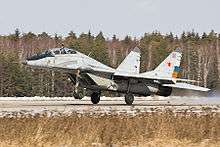
Refined versions of the MiG-29 with improved avionics were fielded by the Soviet Union, but Mikoyan's multirole variants, including a carrier-based version designated MiG-29K, were never produced in large numbers. Development of the MiG-29K carrier version was suspended for over a decade before being resumed; the type went into service with the Indian Navy's INS Vikramaditya, and Russian Navy's Admiral Kuznetsov class aircraft carrier.
Mikoyan had developed improved versions of the MiG-29, called MiG-29M/M2 and MiG-29SMT. On 15 April 2014, the Russian Air Force placed an order for a batch of 16 MiG-29SMT fighters.[16]
There have been several upgrade programmes conducted for the MiG-29. Common upgrades include the adoption of standard-compatible avionics, service life extensions to 4,000 flight hours, safety enhancements, greater combat capabilities and reliability. In 2005, the Russian Aircraft Corporation “MiG” established a unified family of 4++ generation multirole fighters: the aircraft carrier–based MiG-29K, front-line MiG-29M and MiG-35 fighters.
Replacement
On 11 December 2013, Russian deputy prime minister Dmitry Rogozin revealed that Russia was planning to build a new fighter to replace the MiG-29. The Sukhoi Su-27 and its derivatives were to be replaced by the Sukhoi Su-57, but a different design was needed to replace the lighter MiGs. A previous attempt to develop a MiG-29 replacement, the MiG 1.44 demonstrator, failed in the 1990s. The concept came up again in 2001 with interest from India, but they later opted for a variant of the Su-57. Air Force commanders have hinted at the possibility of a single-engine airframe that uses the Su-57's engine, radar, and weapons primarily for Russian service.[17]
Design
Overview
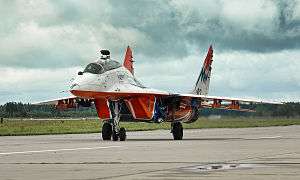
Sharing its origins in the original PFI requirements issued by TsAGI, the MiG-29 has broad aerodynamic similarities to the Sukhoi Su-27, however, there are some notable differences. The MiG-29 has a mid-mounted swept wing with blended leading-edge root extensions (LERXs) swept at around 40°; there are swept tailplanes and two vertical fins, mounted on booms outboard of the engines. Automatic slats are mounted on the leading edges of the wings; they are four-segment on early models and five-segment on some later variants. On the trailing edge, there are maneuvering flaps and wingtip ailerons.[18]
The MiG-29 has hydraulic controls and a SAU-451 three-axis autopilot but, unlike the Su-27, no fly-by-wire control system. Nonetheless, it is very agile, with excellent instantaneous and sustained turn performance, high-alpha capability, and a general resistance to spins. The airframe consists primarily of aluminum with some composite materials, and is stressed for up to 9 g (88 m/s²) maneuvers. The controls have "soft" limiters to prevent the pilot from exceeding g and alpha limits, but the limiters can be disabled manually.[18]
Powerplant and range
The MiG-29 has two widely spaced Klimov RD-33 turbofan engines, each rated at 50.0 kN (11,240 lbf) dry and 81.3 kN (18,277 lbf) in afterburner. The space between the engines generates lift, thereby reducing effective wing loading, hence improving maneuverability. The engines are fed through intake ramps fitted under the leading-edge extensions (LERXs), which have variable ramps to allow high-Mach speeds. As an adaptation to rough-field operations, the main air inlet can be closed completely and the auxiliary air inlet on the upper fuselage can be used for takeoff, landing and low-altitude flying, preventing ingestion of ground debris. Thereby the engines receive air through louvers on the LERXs which open automatically when intakes are closed. However the latest variant of the family, the MiG-35, eliminated these dorsal louvers, and adopted the mesh screens design in the main intakes, similar to those fitted to the Su-27.[19]
The MiG-29 has a ferry range of 1,500 km without external fuel tanks, and 2,100 km with external tanks.[20] The internal fuel capacity of the original MiG-29B is 4,365 litres distributed between six internal fuel tanks, four in the fuselage and one in each wing. For longer flights, this can be supplemented by a 1,500-litre (330 Imp gal, 395 US gal) centreline drop tank and, on later production batches, two 1,150-litre (253 Imp gal, 300 US gal) underwing drop tanks. In addition, a newer models have been fitted with port-side inflight refueling probes, allowing much longer flight times by using a probe-and-drogue system.[21]
Cockpit
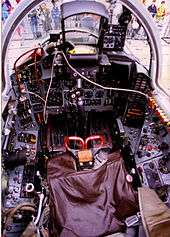
The cockpit features a conventional centre stick and left hand throttle controls. The pilot sits in a Zvezda K-36DM ejection seat which has had impressive performance in emergency escapes.
The cockpit has conventional dials, with a head-up display (HUD) and a Shchel-3UM helmet mounted display, but no HOTAS ("hands-on-throttle-and-stick") capability. Emphasis seems to have been placed on making the cockpit similar to the earlier MiG-23 and other Soviet aircraft for ease of conversion, rather than on ergonomics. Nonetheless, the MiG-29 does have substantially better visibility than most previous Russian jet fighters, thanks to a high-mounted bubble canopy. Upgraded models introduce "glass cockpits" with modern liquid-crystal (LCD) multi-function displays (MFDs) and true HOTAS.
Sensors
The baseline MiG-29B has a Phazotron RLPK-29 radar fire control system which includes the N019 Sapfir 29 look-down/shoot-down coherent pulse-Doppler radar and the Ts100.02-02 digital computer.
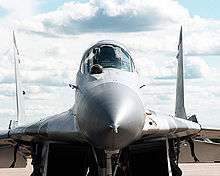
The N019 radar was not a new design, but rather a development of the Sapfir-23ML architecture used on the MiG-23ML. During the initial design specification period in the mid-1970s, Phazotron NIIR was tasked with producing a modern radar for the MiG-29. To speed development, Phazotron based its new design on work undertaken by NPO Istok on the experimental "Soyuz" radar program. Accordingly, the N019 was originally intended to have a flat planar array antenna and full digital signal processing, for a detection and tracking range of at least 100 km against a fighter-sized target. Prototype testing revealed this could not be attained in the required timeframe and still fit within the MiG-29's nose. Rather than design a new radar, Phazotron reverted to a version of the Sapfir-23ML's twisted-polarization cassegrain antenna and traditional analog signal processors, coupled with a new NII Argon-designed Ts100 digital computer to save time and cost. This produced a working radar system, but inherited the weak points of the earlier design, plaguing the MiG-29's ability to detect and track airborne targets at ranges available with the R-27 and R-77 missiles.
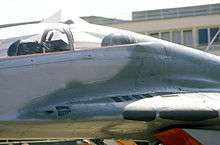
The N019 was further compromised by Phazotron designer Adolf Tolkachev’s betrayal of the radar to the CIA, for which he was executed in 1986. In response to all of these problems, the Soviets hastily developed a modified N019M Topaz radar for the upgraded MiG-29S aircraft. However, VVS was reportedly still not satisfied with the performance of the system and demanded another upgrade. The latest upgraded aircraft offered the N010 Zhuk-M, which has a planar array antenna rather than a dish, improving range, and a much superior processing ability, with multiple-target engagement capability and compatibility with the Vympel R-77 (or RVV-AE).
Armament
Armament for the MiG-29 includes a single GSh-30-1 30 mm cannon in the port wing root. This originally had a 150-round magazine, which was reduced to 100 rounds in later variants. Original production MiG-29B aircraft cannot fire the cannon when carrying a centerline fuel tank as it blocks the shell ejection port. This was corrected in the MiG-29S and later versions. Three pylons are provided under each wing (four in some variants), for a total of six (or eight). The inboard pylons can carry either a 1,150 liter (300 US gal) fuel tank, one Vympel R-27 (AA-10 "Alamo") medium-range air-to-air missile, or unguided bombs or rockets. Some Soviet aircraft could carry a single nuclear bomb on the port inboard station. The outer pylons usually carry R-73 (AA-11 "Archer") dogfight air to air missiles, although some users still retain the older R-60 (AA-8 "Aphid"). A single 1,500-litre (400 US gal) tank can be fitted to the centerline, between the engines.
Operational history
While the MiG-29's true capabilities could only be estimated from the time it first appeared In 1977 until the mid-1980s, a combination of persistent intelligence and increasing access afforded by the Soviet foreign sales effort allowed a true appreciation of its capabilities. Early MiG-29s were very agile aircraft, capable of rivalling the performance of contemporary F-18 and F-16 aircraft. However, their relatively low fuel capacity relegated them to short-range air defense missions. Lacking HOTAS and an inter-aircraft data link, and requiring a very intensive "heads-down" approach to operating cockpit controls, the early MiG-29 denied pilots the kind of situational awareness routinely enjoyed by pilots operating comparable US aircraft. Analysts and Western pilots who flew examples of the MiG-29 thought this likely prevented even very good pilots from harnessing the plane's full combat capability. Later MiG-29s were upgraded to improve their capabilities.[22] The Soviet Union exported MiG-29s to several countries. Because 4th-generation fighter jets require the pilots to have extensive training, air-defense infrastructure, and constant maintenance and upgrades, MiG-29s have had mixed operational history with different air forces.[23]
Soviet Union and successor states
The MiG-29 was first publicly seen in the West when the Soviet Union displayed the aircraft in Finland on 2 July 1986. Two MiG-29s were also displayed at the Farnborough Airshow in Britain in September 1988. The following year, the aircraft conducted flying displays at the 1989 Paris Air Show where it was involved in a non-fatal crash during the first weekend of the show.[24] The Paris Air Show display was only the second display of Soviet fighters at an international air show since the 1930s. Western observers were impressed by its apparent capability and exceptional agility. Following the disintegration of the Soviet Union, most of the MiG-29s entered service with the newly formed Russian Air Force.
Russia

In July 1993, two MiG-29s of the Russian Air Force collided in mid-air and crashed away from the public at the Royal International Air Tattoo. No one on the ground sustained any serious injuries, and the two pilots ejected and landed safely.[25]
.jpg)
The Russian Air Force grounded all its MiG-29s following a crash in Siberia on 17 October 2008.[26] Following a second crash with a MiG-29 in east Siberia in December 2008,[27][28] Russian officials admitted that most MiG-29 fighters in the Russian Air Force were incapable of performing combat duties due to poor maintenance. The age of the aircraft was also an important factor as about 70% of the MiGs were considered to be too old to take to the skies.[29] The Russian MiG-29s have not received updates since the collapse of the Soviet Union. On 4 February 2009, the Russian Air Force resumed flights with the MiG-29.[30] However, in March 2009, 91 MiG-29s of the Russian Air Force required repair after inspections due to corrosion; approximately 100 MiGs were cleared to continue flying at the time.[31][32] The Russian Air Force started an update of its early MiG-29s to the more current MiG-29SMT standard,[20] but financial difficulties prevented delivery of more than three MiG-29 SMT upgrade to the Russian Air Force.[33] Instead, the 35 MiG-29SMT/UBTs rejected by Algeria were bought by the Russian Air Force.[34] Russia placed an order for 16 new-build MiG-29SMTs on 15 April 2014, with delivery expected by 2017.[35]
On 4 June 2015, a MiG-29 crashed during training in Astrakhan.[36] A month later, another MiG-29 crashed near the village of Kushchevskaya in the Krasnodar region with the pilot safely ejecting.[37] A series of accidents in the Russian Air Force that happened in 2015 were caused mostly by overall increase of flights and trainings.[38]
Combat
On 20 April 2008, Georgian officials claimed a Russian MiG-29 shot down a Georgian Hermes 450 unmanned aerial vehicle and provided video footage from the ill-fated drone showing an apparent MiG-29 launching an air-to-air missile at it. Russia denies that the aircraft was theirs and says they did not have any pilots in the air that day. Abkhazia's administration claimed its own forces shot down the drone with an L-39 aircraft "because it was violating Abkhaz airspace and breaching ceasefire agreements."[39] UN investigation concluded that the video was authentic and that the drone was shot down by a Russian MiG-29 or Su-27 using a R-73 heat seeking missile.[40]
On 16 July 2014, a Ukrainian Su-25 was shot down, with Ukrainian officials stating that a Russian MiG-29 shot it down using a R-27T missile.[41][42] Russia denied these allegations.[43]
During the first half of September 2017, the Russian Air Force deployed some MiG-29SMT multirole combat aircraft to Hmeymim airbase, near Latakia, in western Syria, becoming the first time the modernized version of the baseline Fulcrum jet was deployed to take part in the Syrian Air War.[44] The MiG-29SMT were involved in bombing missions and secondary strategic bombers escort duties.[45]
Ukraine
.jpg)
In April 2014, during the military intervention in Crimea, 45 Ukrainian Air Force MiG-29s and 4 L-39 combat trainers were reportedly captured by Russian forces at Belbek air base. Most of the planes appeared to be in inoperable condition. In May, Russian troops dismantled them and shipped them back to Ukraine. On 4 August 2014, the Ukrainian government stated that a number of them had been put back into service to fight in the war in the east of the country.[46]
During the initial days of the War in Donbass in April 2014, the Ukrainian Air Force deployed some jet fighters over the Donetsk region to perform combat air patrols and show of force flights. Probably due to the limited number of jet fighters available, a MiG-29 belonging to the Ukrainian Falcons display team was spotted armed with a full air-to-air load and performing a low altitude fly by.[47]
In the evening of 7 August 2014, a Ukrainian Air Force MiG-29MU1, bort number 02 Blue, was shot down by an antiaircraft missile fired by pro-Russian rebels near the town of Yenakievo, and exploded in midair. The pilot ejected safely.[48][49][50]
On 17 August 2014, another Ukrainian Air Force MiG-29, bort number 53 White, tasked with air to ground duties against rebel positions[51] was shot down by pro-Russian rebels in the Luhansk region. The Ukrainian government confirmed the downing. The pilot ejected safely and was recovered by friendly forces.[52][53]
As of 2018, the Lviv State Aviation Repair Plant began domestically upgrading the MiG-29 to have multirole capability, known as the MiG-29MU2. Development is expected to be completed by 2019 and enter production in 2020.[54]
On 29 May 2020, Ukrainian MiG-29s took part in the Bomber Task Force in Europe with American B-1B bombers for the first time in the Black Sea region.[55]
Export
India
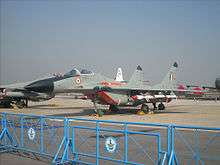
India was the first international customer of the MiG-29. The Indian Air Force (IAF) placed an order for more than 66 MiG-29s in 1980 while the aircraft was still in its initial development phase. Since its induction into the IAF in 1985, the aircraft has undergone a series of modifications with the addition of new avionics, sub-systems, turbofan engines and radars.[56]
Indian MiG-29s were used extensively during the 1999 Kargil War in Kashmir by the Indian Air Force to provide fighter escort for Mirage 2000s attacking targets with laser-guided bombs.[57]
The MiG-29's good operational record prompted India to sign a deal with Russia in 2005–2006 to upgrade all of its MiG-29s for US$888 million. Under the deal, the Indian MiGs were modified to be capable of deploying the R-77RVV-AE (AA-12 'Adder') air-to-air missile. The missiles had been successfully tested in October 1998 and were integrated into IAF's MiG-29s. IAF has also awarded the MiG Corporation another US$900 million contract to upgrade all of its 69 operational MiG-29s. These upgrades will include a new avionics kit, with the N-109 radar being replaced by a Phazotron Zhuk-M radar. The aircraft is also being equipped to enhance beyond-visual-range combat ability and for air-to-air refuelling to increase endurance.[58] In 2007, Russia also gave India's Hindustan Aeronautics Limited (HAL) a licence to manufacture 120 RD-33 series 3 turbofan engines for the upgrade.[59] The upgrade will also include a new weapon control system, cockpit ergonomics, air-to-air missiles, high-accuracy air-to-ground missiles and "smart" aerial bombs. The first six MiG-29s will be upgraded in Russia while the remaining 63 MiGs will be upgraded at the HAL facility in India. India also awarded a multimillion-dollar contract to Israel Aircraft Industries to provide avionics and subsystems for the upgrade.[60]
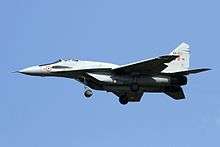
In March 2009, the Indian Air Force expressed concern after 90 MiG-29s were grounded in Russia.[61] After carrying out an extensive inspection, the IAF cleared all MiG-29s in its fleet in March 2009.[62] In a disclosure in Parliament, Defence Minister A. K. Antony said the MiG-29 is structurally flawed in that it has a tendency to develop cracks due to corrosion in the tail fin. Russia has shared this finding with India, which emerged after the crash of a Russian Air Force MiG-29 in December 2008. "A repair scheme and preventive measures are in place and IAF has not encountered major problems concerning the issue," Antony said.[63] Despite concerns of Russia's grounding, India sent the first six of its 78 MiG-29s to Russia for upgrades in 2008. The upgrade program will fit the MiGs with a phased array radar (PESA) and in-flight re-fuelling capability.[23]
In January 2010, India and Russia signed a US$1.2 billion deal under which the Indian Navy would acquire 29 additional MiG-29Ks, bringing the total number of MiG-29Ks on order to 45.[64] The MiG-29K entered service with the Indian Navy on 19 February 2010.[65]
The upgrades to Indian MiG-29s will be to the MiG-29UPG standard. This version is similar to the SMT variant but differs by having a foreign-made avionics suite.[66] The upgrade to latest MiG-29UPG standard is in process, which will include latest avionics, Zhuk-ME Radar, engine, weapon control systems, enhancing multirole capabilities by many-fold.[67][68] As of 2012, Indian UPG version is the most advanced MiG-29 variant.[69] The Director-General of MiG, Sergei Korotkov said, "The most advanced is the MiG-29UPG, implemented in India in collaboration with local industry".[69] The first three aircraft were delivered in December 2012, over two years behind schedule.[70] The IAF is in advanced stages of talks to buy a new squadron of upgraded multi-role MiG-29s from Russia using three-decade old MiG-29s.[71]
An IAF MiG-29 crashed near Jalandhar in Punjab on 8 May 2020 with its pilot ejected safely after the aircraft failed to respond. A court of inquiry has been ordered in the incident.[72]
Yugoslavia and Serbia
Yugoslavia was the first European country outside the Soviet Union to operate the MiG-29. The country received 14 MiG-29Bs and two MiG-29UBs from the USSR in 1987 and 1988. The MiG-29s were put into service with the 127th Fighter Aviation Squadron, based at Batajnica Air Base, north of Belgrade, Serbia.[73]
Yugoslav MiG-29s saw little combat during the breakup of Yugoslavia, and were used primarily for ground attacks. Several Antonov An-2 aircraft used by Croatia were destroyed on the ground at Čepin airfield near Osijek, Croatia in 1991 by a Yugoslav MiG-29, with no MiG-29 losses.[74] At least two MiG-29 carried out an air strike on Banski dvori, the official residence of the Croatian Government, on 7 October 1991.[75]
The MiG-29s continued their service in the subsequent Federal Republic of Yugoslavia. Because of the United Nations arms embargo against the country, the condition of the MiG-29s worsened.[76]
A total of six MiG-29s were shot down during the NATO intervention in the Kosovo War, of which three were shot down by USAF F-15s, one by a USAF F-16, and one by a RNLAF F-16.[77][78] One aircraft, according to pilot, was hit by friendly fire from the ground.[79] Another four were destroyed on the ground.[80] One Argentine source claims that a MiG-29 shot down an F-16 on 26 March 1999,[81] but this kill is disputed, as the F-16C in question was said to have crashed in the US that same day.[82]

The Air Force of Serbia and Montenegro continued flying its remaining five MiG-29s at a very low rate after the war with one of them crashing on 7 July 2009. In spring 2004, news appeared that MiG-29 operations had ceased, because the aircraft could not be maintained,[74] but later the five remaining airframes were sent to Russia for overhauling. The small Serbian MiG-29 fleet along with other jets were grounded for four months during Summer 2014 due to a battery procurement issue. The Serbian Air Force operates three MiG-29s as of late 2014, with one airframe grounded due to structural issues.[83]
In November 2016, Russia had agreed to donate six of its MiG-29s free of charge, if Serbia would pay the repair costs of $50 million for them.[84][85] At the end of January 2017, Serbian defense minister Zoran Đorđević said that Belarus also agreed to donate eight of its MiG-29s to Serbia on a no-pay basis.[86][87] In early October 2017, Russia completed the delivery of all the six MiG-29s. The aircraft were transferred to Serbia on board the Antonov An-124 transport aircraft.[88][89] On 25 February 2019, Belarus formally handed four MiG-29s to the Serbian military during a ceremony held at the 558th Aircraft Repair Plant in Baranavichy. This increased the total number of MiG-29s in the Serbian Air Force to 14.[90] Serbia plans to spend about €180–230 million on modernization of its entire MiG-29 fleet.[91][92]
Germany
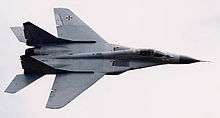
East Germany bought 24 MiG-29s (20 MiG-29As, four MiG-29UBs), which entered service in 1988–1989 in 1./JG3 "Wladimir Komarow" in Preschen in Brandenburg.[93] After the fall of the Berlin Wall in November 1989 and reunification of Germany in October 1990, the MiG-29s and other aircraft of the East German Air Forces of the National People's Army were integrated into the West German Luftwaffe.[94] Initially the 1./JG3 kept its designation. In April 1991 both 1./JG3's MIG-29 squadrons were reorganised into the MIG-29 test wing ("Erprobungsgeschwader MIG-29"), which became JG73 "Steinhoff" and was transferred to Laage near Rostock in June 1993.
The Federation of American Scientists claims the MiG-29 is equal to, or better than the F-15C in some areas such as short aerial engagements because of the Helmet Mounted Weapons Sight (HMS) and better maneuverability at slow speeds.[95] This was demonstrated when MiG-29s of the German Air Force participated in joint DACT exercises with US fighters.[96][97] The HMS was a great help, allowing the Germans to achieve a lock on any target the pilot could see within the missile field of view, including those almost 45 degrees off boresight.[98] However the German pilots who flew the MiG-29 admitted that while the Fulcrum was more maneuverable at slow speeds than the F-15 Eagle, F-16 Fighting Falcon, F-14 Tomcat, and F/A-18 Hornet and its Vympel R-73 dogfight missile system was superior to the AIM-9 Sidewinder of the time, all of the American-made fighters had superior avionics, radar, and beyond visual range missiles. In engagements that went into the beyond visual range arena the German pilots found it difficult to multi-task locking and firing the MiG-29's Vympel R-27 missile (German MiG-29s did not have access to the more advanced Vympel R-77 that equips other nations' MiG-29s) while trying to avoid the longer range and advanced search and track capabilities of the American fighters' radars and AIM-120 AMRAAM. The Germans also stated that the American fighters had the advantage in both night and bad weather combat conditions. The Luftwaffe's assessment of the MiG-29 was that the Fulcrum was best used as a point defense interceptor over cities and military installations; not for fighter sweeps over victim airspace. This assessment ultimately led Germany to not deploy its MiG-29s in the Kosovo War during Operation Allied Force, though Luftwaffe pilots who flew the MiG-29 admitted that even if they were permitted to fly combat missions over the former Yugoslavia they would have been hampered by the lack of NATO specific communication tools and Identification friend or foe systems.[99][100]
Beginning in 1993, the German MiGs were stationed with JG73 "Steinhoff" in Laage near Rostock. During the service in the German Air Force, one MiG-29 ("29+09") was destroyed during an accident on 25 June 1996 due to pilot error. By 2003, German Air Force pilots had flown over 30,000 hours in the MiG-29. In September 2003, 22 of the 23 remaining machines were sold to the Polish Air Force for the symbolic price of €1 per item.[101] The last aircraft were transferred in August 2004.[102] The 23rd MiG-29 ("29+03") was put on display at Laage.[103]
Peru
The Peruvian Air Force acquired 21 MiG-29S fighters from Belarus in 1997, as part of a package that also included 18 Su-25 attack aircraft. The following year an additional 3 MiG-29 aircraft were acquired from Russia. At the same time, Peru contracted with Mikoyan to upgrade 8 aircraft to the MiG-29SMP standard, with an option to upgrade the remainder of the Peruvian inventory. The Peruvian MiG-29s are based at FAP Captain José Abelardo Quiñones González International Airport in northern Peru, equipping Escuadrón Aéreo 612 (Fighter Squadron 612 "Fighting Roosters").[104]
Poland
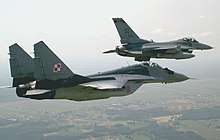
The first 12 MiG-29 (nine MiG-29As, three MiG-29UB) were delivered to Poland in 1989–1990. The aircraft were based at Mińsk Mazowiecki and used by the 1st Fighter Aviation Regiment, which was reorganized in 2001 as 1 Eskadra Lotnictwa Taktycznego (1. elt), or 1st Tactical Squadron (TS). In 1995–1996, 10 used examples were acquired from the Czech Republic (nine MiG-29As, one MiG-29UB). After the retirement of its MiG-23s in 1999, and MiG-21s in 2004, Poland was left for a time with only these 22 MiG-29s in the interceptor role.
Of the 22 MiG-29s Poland received from the German Air Force in 2004, a total of 14 were overhauled and taken into service. They were used to equip the 41st Tactical Squadron (41. elt), replacing its MiG-21s. As of 2008, Poland was the biggest NATO MiG-29 user. The possibility of modernizing the fighters to enable them to serve until 2020–2025 is being contemplated, depending on whether cooperation with Mikoyan can be established. Poland has 31 active MiG-29s (25 MiG-29As, 6 MiG-29UBs) as of 2017.[105] They are stationed with the 1st Tactical Squadron at the 23rd Air Base near Mińsk Mazowiecki and the 41st TS at the 22nd Air Base near Malbork.
There have been unconfirmed reports that Poland had at one point leased a MiG-29 from its own inventory to Israel for evaluation and the aircraft has since been returned to Poland, as suggested by photographs of a MiG-29 in Israeli use. Three Polish MiG-29A were reported in Israel for evaluation between April and May 1997 at Negev desert.[106] On 7 September 2011, the Polish Air Force awarded a contract to the WZL 2 company to modernise its MiG-29 fleet to be compatible with Polish F-16s.[107]
Four MiG-29s from 1. elt performed Baltic Air Policing Quick Reaction Alert mission in 2006, while 41. elt aircraft in 2008, 2010 and 2012. Polish MiG-29s played the aggressor role in NATO Tactical Leadership Programme (TLP) joint training program in Albacete, Spain in 2011, 2012 and 2013.[108]
On 18 December 2017, a MiG-29 crash-landed in a forest near 23rd Air Base while performing a landing approach.[109] The pilot survived. Reports afterward were contradictory whether he ejected or not.[110] On 21 December 2017, the MoD confirmed that the pilot did not eject.[111] This was the first crash of a MiG-29 during its nearly three decades–long operational history in the Polish Air Force.[112] On 6 July 2018, another MiG-29 crashed near Pasłęk, with its pilot dying in an ejection attempt. Technical issues are suspected to have played a role in the crash.[113] Another crash followed on 4 March 2019.[114] This time the pilot ejected and survived.[115]
Iraq
Iraq received a number of MiG-29 fighters and used them to engage Iranian equivalent opponents during the later stages of the Iran–Iraq War. According to World Airpower Journal, Two Iranian F-14s were shot down over the Gulf in July 1988.[116]
MiG-29s also saw combat in the 1991 Persian Gulf War with the Iraqi Air Force. Five MiG-29s were shot down by USAF F-15s.[117] Some Russian sources reported that one British Panavia Tornado, ZA467, was shot down in northwestern Iraq by a MiG-29 piloted by Jameel Sayhood.[118][119] UK sources claim this Tornado to have crashed on 22 January on a mission to Ar Rutbah.[120] Other Iraqi air-to-air kills are reported in Russian sources, where the US claims other cases of combat damage, such as a B-52 which the US claims was hit by friendly fire, when an AGM-88 high-speed, anti-radiation missile (HARM) homed on the fire-control radar of the B-52's tail gun; the bomber returned to base and was subsequently renamed "In HARM's Way".[121] It is believed that an F-111 was hit by MiG-29 but it was able to return to base.[122]
Iraq's original fleet of 37 MiG-29s was reduced to 12 after the Gulf War. One MiG-29 was damaged, and four were evacuated to Iran.[123] The remaining 12 aircraft were withdrawn from use in 1995 because the engines needed to be overhauled but Iraq could not send them off for that work.[124]
After the American-led 2003 invasion of Iraq and disbandment of the Ba'athist Iraqi Army in May of the same year,[125] the remaining Russian-made and Chinese-made fighters of Iraqi forces had been decommissioned.
Syria
Syrian Arab Air Force MiG-29s have sometimes encountered Israeli fighter and reconnaissance aircraft. Two Israeli F-15Cs reportedly shot down two MiG-29As on 2 June 1989 under unclear circumstances.[126][127]
Further reports claim that on 14 September 2001 two Syrian Air Force MiG-29s were shot down by two Israeli F-15Cs while the MiGs were intercepting an Israeli reconnaissance aircraft off the coast of Lebanon. However, both Syria and Israel deny that this occurred.[127][128][129]
Syrian MiG-29s entered the Syrian Civil War in late October 2013, attacking Free Syrian Army insurgents with unguided rockets and bombs in Damascus.[130]
Sudan
_MTI-2.jpg)
There have been occasional claims regarding the use of Sudanese Air Force MiG-29s against insurgent forces in Darfur. However, whereas Mi-24 combat helicopters as well as A-5 or, more recently, Su-25 ground-attack aircraft have been spotted and photographed on Darfurian air fields, no MiG-29s have been observed. On 10 May 2008, a Darfur rebel group, the Justice and Equality Movement (JEM) mounted an assault on the Sudanese capital. During this action, the JEM shot down a Sudanese Air Force MiG-29 with 12.7 mm and 14.5 mm heavy machine gun fire while it was attacking a convoy of vehicles in the Khartoum suburb of Omdurman. The aircraft was piloted by a Russian mercenary. He was killed in action as his parachute did not open after ejecting.[131][132][133] On 14 November 2008 Sudanese Ministry of Defence admitted that Sudan had received 12 MiG-29 from Russia.[134] An anonymous Russian source claimed that the aircraft had been delivered before 2004[134]
During the brief 2012 South Sudan–Sudan border conflict, on 4 April 2012, Sudan People's Liberation Army (SPLA) claimed the downing of a Sudanese MiG-29 using antiaircraft guns. The Sudan government denied the claim.[135] On 16 April 2012, the SPLA issued a second claim about the downing of a Sudanese MiG-29.[136] It was not clear if this second claim referred to the previous one.
United States
In 1997, the United States purchased 21 Moldovan MiG-29 aircraft under the Nunn–Lugar Cooperative Threat Reduction program. Fourteen were MiG-29S models, which are equipped with an active radar jammer in its spine and are capable of being armed with nuclear weapons. Part of the United States’ motive to purchase these aircraft was to prevent them from being sold to Iran.[137] This purchase could also provide the tactical jet fighter communities of the USAF, the USN and the USMC with a working evaluation and data for the MiG-29, and possibly for use in dissimilar air combat training. Such information may prove valuable in any future conflicts and can aid in the design and testing of current and future weapons platforms. In late 1997, the MiGs were delivered to the National Air and Space Intelligence Center (NASIC) at Wright-Patterson Air Force Base in Ohio, though many of the former Moldovan MiG-29s are believed to have been scrapped. Some of these MiG-29s are currently on open display at Nellis AFB, Nevada; NAS Fallon, Nevada; Goodfellow AFB, Texas; and Wright-Patterson AFB, Ohio.
Others
The Korean People's Air Force is believed to operate about 40 MiG-29Bs and MiG-29SEs divided into the 55th and 57th fighter regiments based at Sunchon and Onchon, respectively.[138] These were first encountered and photographed by the USAF in March 2003 when a pair of KPAF MiG-29s intercepted an USAF RC-135S reconnaissance aircraft.[139][140][141]
A Cuban MiG-29UB shot down two Cessna 337s belonging to the organisation Brothers to the Rescue in 1996, after the aircraft approached Cuban airspace.[142]
According to some reports, in the 1999 Eritrean-Ethiopian War, a number of Eritrean MiG-29s were shot down by Ethiopian Su-27s piloted by Russian mercenaries.[143] (It is true that local pilots were trained by instructors from those nations.[144]) There are also some other reports of Eritrean MiG-29s shooting down two Ethiopian MiG-21s, three MiG-23s, and a Su-25.[145]
The Bangladesh Air Force (BAF) currently operates 8 MiG-29s (6SE & 2UB).[146]
Yemeni President Ali Abdullah Saleh went to Moscow and signed a major arms deal including naval patrol vessels, training of Yemeni military personnel and a purchase of up to 44 upgraded MiG-29s. The deal successfully went ahead and Yemen also received two additional jets from Kazakhstan. Russia trained 15 pilots on MiG-29s. Equipped with N019MP radar and an advanced fire control system they became the most advanced combat aircraft the Yemeni Air force has had. They are compatible with Kh-31 and Kh-29 guided air to ground missiles and R-77 guided air to air missiles.[147]
Potential operators
In December 2008, Russia moved to expand its military influence in the Middle East when it announced it was giving Lebanon 10 fighter jets, that would have been the most significant upgrade of Lebanon's military since the civil war ended almost two decades before. A Russian defense ministry representative said it was giving secondhand MiG-29s to Lebanon for free. This was to be part of a defense cooperation deal that would have seen Moscow train Lebanese military personnel.[148] On 29 February 2010, Russia agreed to change the offer to 10 Mi-24 attack helicopters based on a Lebanese request.[149] The Argentine Air Force will seek to purchase over 15 MiG-29 multirole fighters from Russia.[147]
Variants
Original Soviet variants
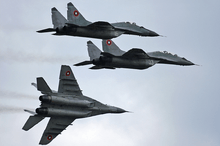
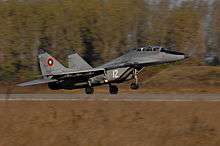
- MiG-29A (Product 9.12)[150]
- Initial production version; entered service in 1983. NATO reporting name is "Fulcrum-A". 9.12A is the Initial production model version for Warsaw Pact while the 9.12B is the downgraded export version for non-Warsaw Pact nations. 9.12A lacks a nuclear weapon delivery system and has initial production radar, ECM and IFF (no ECM and IFF in 9.12B).
- MiG-29UB (Product 9.51)
- Twin seat training model. Infra-red sensor mounted only, no radar. NATO reporting code is "Fulcrum-B". Export variant had downgraded systems similar to MiG-29 9.12.
Upgraded variants based on original airframe
- MiG-29S (Product 9.13)
- The MiG-29S, given the NATO reporting code "Fulcrum-C", features flight control system improvements; a total of four new computers provide better stability augmentation and controllability with an increase of 2° in angle of attack (AoA). An improved mechanical-hydraulic flight control system allows for greater control surface deflections. The MiG-29S has a dorsal hump, which led to its nickname "Fatback", houses the L-203BE Gardenyia-1 ECM system. The MiG-29S can carry 1,150 liter (304 US gallon, 2,000 lb) under wing drop tanks and a centerline tank. The inboard underwing hardpoints allow a tandem pylon arrangement for carrying a larger payload of 4,000 kg (8,820 lb). Overall maximum gross weight has been raised to 20,000 kg (44,000 lb). Built only for domestic use. Early MiG-29S featured an IRST sighting system; the MiG-29S improvement kit includes the Phazotron N019M radar and Built-In Test Equipment (BITE) to reduce dependence on ground support equipment; MiG MAPO designates this as MiG-29SD. Improvements to software and processing capabilities enables the tracking of up to 10 targets and the simultaneous engagement of two with the R-77 missile. The MiG-29S also has a limited ground-attack capability.
- MiG-29SE
- Export model of MiG-29S with slightly downgraded N-019ME radar with multiple target tracking ability and RVV-AE (R-77 missile) compatibility. The first export model MiG-29 with underwing drop tanks; the inner underwing pylons can carry over 500 kg bombs in side by side tandem pairs. Its weapons mix includes R-27T1, R-27ER1 and R-27ET1 medium-range missiles. The aircraft can be fitted with active ECM systems, weapons guidance aids, improved built-in check and training systems. The MiG-29SE can simultaneously engage two air targets.
- MiG-29SM (Product 9.13M)
- Similar to the 9.13, but with the ability to carry guided air-to-surface missiles and TV- and laser-guided bombs. NATO reporting code is "Fulcrum-C".
- MiG-29SM (SyAF)
- For the Syrian Air Force, and based on the MiG-29SM, except the Syrian MiG-29SM uses the 9.12 airframe. RAC MiG developed a special variant for Syria.[151]
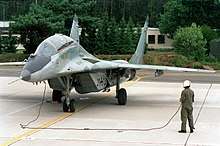
- MiG-29G/MiG-29GT
- East German MiG-29 / 29UB upgraded to NATO standards, with work done by MiG Aircraft Product Support GmbH (MAPS), a joint venture company form between MiG Moscow Aviation Production Association and DaimlerChrysler Aerospace in 1993.[152]
- MiG-29AS/MiG-29UBS (MiG-29SD)
- Slovak Air Force performed an upgrade on their MiG-29/-29UB for NATO compatibility. Work is done by RAC MiG and Western firms, starting from 2005. The aircraft now has navigation and communications systems from Rockwell Collins, an IFF system from BAE Systems, new glass cockpit features multi-function LC displays and digital processors and also fitted to be integrate with Western equipment in the future. However, the armaments of the aircraft remain unchanged. 12 out of 21 of the entire MiG-29 fleet were upgraded and had been delivered as of late February 2008.[153]
- MiG-29 Sniper
- Upgrade planned for Romanian Air Force, by Israeli firms. First flight occurred on 5 May 2000. The program was halted along with the retiring of Romanian MiG-29s in 2003. The latter occurred because of high maintenance costs, which led to the Romanian Government's decision to halt the MiG-29 program and further invest in the MiG-21 LanceR program.
%2C_Russia_-_Air_Force_AN2269907.jpg)
- MiG-29SMT (Product 9.17)
- The MiG-29SMT is an upgrade package for first-generation MiG-29s (9.12 to 9.13) containing enhancements intended for the MiG-29M variant. Additional fuel tanks in a further enlarged spine provide a maximum flight range of 2,100 km on internal fuel. The cockpit has an enhanced HOTAS design, two 152 × 203 mm (6 × 8-inch) colour liquid crystal MFDs and two smaller monochrome LCDs. The MiG-29A was not designed for an advanced air-to-ground capability, this is substantially improved by the SMT upgrade; features include air-to-ground radar detection and integrated air-to-ground guided weapons.[154] The upgraded Zhuk-ME radar provides similar features to the MiG-29M. The power plant are upgraded RD-33 ser.3 engines with afterburning thrust rated at 8,300 kgf (81.4 kN) each. The weapons load was increased to 4,500 kg on six underwing and one ventral hardpoints, with similar weapon choices as for the MiG-29M. The upgraded aircraft can also accommodate non-Russian origin avionics and weapons.[155][156]
- MiG-29BM
- The MiG-29BM (probably Belarusian Modernised, possibly Bolyshaya Modernizaciya – large modernization) is an upgrade to the MiG-29 conducted by the ARZ-558 aircraft repair plant in Baranovichi, Belarus. The MiG-29BM is a strike variant of the MiG-29 pure fighter, the Belarusian counterpart to the Russian MiG-29SMT. It includes improvements to weapons, radar, as well as adding non-retractable air-air refueling ability.[157] They entered service in 2003 and it is estimated, that ten or so were modernized to BM standard.[158]
- MiG-29UBT (Product 9.51T)
- SMT standard upgrade for the MiG-29UB. Namely users, Algeria and Yemen.[159][160]
- MiG-29UPG
- The Indian UPG version is similar to the SMT variant but differs by having a foreign-made avionics suite integrated within it, in the "international avionics suite".[66] The weapons suite is the same as the SMT and K/KUB versions.[66] The design is a new modification intended for the MiG-29s used by Indian Air Force. It made its maiden flight on 4 February 2011. The standard includes the new Zhuk-M radar, new avionics, a IFR probe as well as new enhanced RD-33 series 3 turbofan engines. The modernization is part of a $900 million contract to upgrade the 69 fighters fleet.[161] In 2012, RAC MiG general director's stated the UPG version was the "most advanced" MiG-29 variant.[69]
- MiG-29SMP / MiG-29UBP
- Upgrade for the Peruvian Air Force MiG-29 fleet. In August 2008 a contract of US$ 106 million was signed with RAC MiG for this custom SM upgrade of an initial batch of eight MiG-29, with a provision for upgrade of the remainder of the Peruvian MiG-29 fleet.[162] The single-seat version is designated SMP, whereas the twin-seat version is designated UBP.
- The SMP standard features an improved ECM suite, avionics, sensors, pilot interface, and a MIL-STD-1553 databus. The interfaces include improved IRST capabilities for enhanced passive detection and tracking as well as better off-boresight launch capabilities, one MFCD and HOTAS.[163] The N019M1 radar, a heavily modified and upgraded digital version of the N019 radar, is used instead of the standard N010 Zhuk-M used on the MiG-29SMT. The upgrade also includes a structural life-extension program (SLEP), the overhaul, upgrade of the original engines and the installation of an in-flight refuelling probe.[164]
- MiG-29MU1
- Ukrainian modernization of MiG-29. Range of detection of air targets increased up to 29% (up to 100 km in the forward hemisphere and up to 45 km – at the rear).
Second-generation variants with modified airframe
- MiG-29M / MiG-33 (Product 9.15)
- Advanced multirole variant, with a redesigned airframe, mechanical flight controls replaced by a fly-by-wire system and powered by enhanced RD-33 ser.3M engines. NATO reporting code is "Fulcrum-E".
- MiG-29UBM (Product 9.61)
- Two-seat training variant of the MiG-29M. Never built. Effectively continued under the designation 'MiG-29M2'.
- MiG-29M2 / MiG-29MRCA
- Two-seat version of MiG-29M. Identical characteristics to MiG-29M, with a slightly reduced ferry range of 1,800 km.[165] RAC MiG presented in various air shows, including Fifth China International Aviation and Aerospace Exhibition (CIAAE 2004),[166] Aero India 2005,[167][168] MAKS 2005.[169] It was once given designation MiG-29MRCA for marketing purpose and now evolved into the current MiG-35.
- MiG-29OVT
- The aircraft is one of the six pre-built MiG-29Ms before 1991, later received thrust vectoring engine and fly-by-wire technology. It served as a thrust-vectoring engine testbed and technology demonstrator in various air shows to show future improvement in the MiG-29M. It has identical avionics to the MiG-29M. The only difference in the cockpit layout is an additional switch to turn on vector thrust function. The two RD-133 thrust-vectoring engines, each features unique 3D rotating nozzles which can provide thrust vector deflection in all directions. However, despite its thrust-vectoring, other specifications were not officially emphasized. The aircraft is being demonstrated along with the MiG-29M2 in various air shows around the world for potential export. The aircraft is usually used as an aerobatic demonstrator.[170]
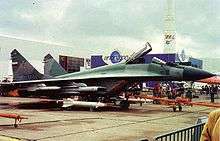

- MiG-29K (Product 9.31)
- Naval variant based on MiG-29M, the letter "K" stands for "Korabelnogo bazirovaniya" (deck-based). It features folding wings, arrestor gear, and reinforced landing gear. Originally intended for the Admiral Kuznetsov class aircraft carriers, it had received series production approval from the Russian Ministry of Defence but was grounded in 1992 due to shift in military doctrine and financial difficulties.[171] The MiG Corporation restarted the program in 1999. On 20 January 2004, the Indian Navy signed a contract of 12 single-seat MiG-29K and four two-seat MiG-29KUB.[171] Modifications were made for the Indian Navy requirement. Production MiG-29K and MiG-29KUB share a two-seater size canopy. The MiG-29K has radar absorbing coatings to reduce radar signature. Cockpit displays consist of wide HUD and three (seven on MiG-29KUB) colour LCD MFDs with a Topsight E helmet-mounted targeting system. It has a full range of weapons compatible with the MiG-29M and MiG-29SMT.[172] NATO reporting code is "Fulcrum-D".
- MiG-29KUB (Product 9.47)
- Identical characteristic to the MiG-29K but with tandem twin seat configuration. The design is to serve as trainer for MiG-29K pilot and is full combat capable. The first MiG-29KUB developed for the Indian Navy made its maiden flight at the Russian Zhukovsky aircraft test centre on 22 January 2007.[173] NATO reporting code is "Fulcrum-D".
- MiG-35
- A recently unveiled mature development of the MiG-29M/M2 and MiG-29K/KUB. NATO reporting code is "Fulcrum-F".
Operators
.jpg)
.jpg)
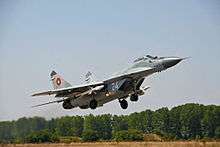
_edited.jpg)
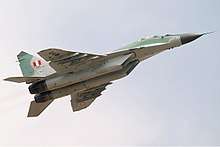
- Algerian Air Force – 26 MiG-29s in service in January 2014.[174][175] 14 MiG-29M/M2s on order.[176]
- Azerbaijani Air Forces – 13 MiG-29s in operational use in January 2014[174][175]
- Bangladeshi Air Force – 8 MiG-29s in service as of 2017[177]
- Belarusian Air Force – 41 MiG-29s in inventory as of January 2014[174]
- Bulgarian Air Force – 16 MiG-29 and 3 MiG-29UB fighters in service,[178] to be replaced by 2024.[179]
- Chadian Air Force – 3 MiG-29s[180] from Ukraine[181]
- Cuban Revolutionary Air and Air Defense Force – 4 MiG-29s in inventory as of January 2014[174]
- Eritrean Air Force – 4 MiG-29s in service as of January 2014[174]
- Indian Air Force – 67 MiG-29s in service as of January 2014[174] with 21 more on order in 2020.[182]
- Indian Naval Air Arm– 45 MiG-29Ks in service as of February 2017[183]
- Islamic Republic of Iran Air Force – 44 MiG-29s in inventory as of 2012[184]
- Kazakh Air and Air Defence Forces – 12 MiG-29 and 2 MiG-29UB as of 2016
- Royal Malaysian Air Force – 16 MiG-29s in inventory with 15 in active reserve as 2019[185][186]
- Mongolian Air Force - 2 MiG-29UBs in active service as of November 2019[187]
- Myanmar Air Force – 31 MiG-29s in January 2015[188]
- Korean People's Air Force – 35 MiG-29s as of January 2015[189]
- Peruvian Air Force – 19 MiG-29s in service as of January 2014[174] with 8 upgraded and 11 to be upgraded.[190][191]
- Polish Air Force – 30 MiG-29s in service as of December 2017[192]
- Russian Aerospace Forces
- Russian Air Force – 256 in inventory as of 2017[193]
- Russian Naval Aviation – 24 MiG-29Ks procured.[194]
- Serbian Air Force and Air Defence – 14 MiG-29s in inventory as of 2019 (5 MiG-29Аs, 3 MIG-29Bs, 3 MiG-29Ss, 3 MiG-29UBs). In November 2017, Serbia received 6 MiG-29s (3 MiG-29Ss, 3 MiG-29UBs) that were donated free of charge from Russia.[88][195] These aircraft were built between 1989–1991.[196] On 25 February 2019, Serbia received 4 single-seat MiG-29As, donated from Belarus.[197][90] All the Serbian Air Force MiG-29s are planned to be modernized to the advanced MiG-29SMT/UBT standards.[91]
- Slovak Air Force – 10 MiG-29ASs and 2 MiG-29UBSs in service since 2008. These aircraft were upgraded by the Russian Aircraft Corporation MiG and Western companies in 2007 and 2008 to fulfill the NATO requirements.[198][199][200] They are maintained by Russian military technicians at Sliač Air Base.[201]
- Sudanese Air Force – 11 in service as of January 2017[202]
- Syrian Arab Air Force – 20 in service with 12 more on order as of January 2017.[202] A new delivery in May 2020.[203]
- Turkmen Air Force – 24 MiG-29s in use as of January 2014[174]
- Ukrainian Air Force – 37 MiG-29s in use as of March 2019[204]
- Used by private defense contractor Air USA for adversary training services.[205]
- Uzbekistan Air and Air Defence Forces – 60 MiG-29s in operation as of January 2014[174]
Former operators
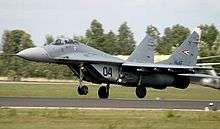



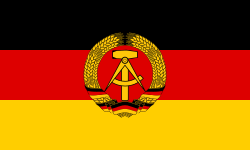


.svg.png)



%3B_Flag_of_Serbia_and_Montenegro_(2003%E2%80%932006).svg.png)


.svg.png)
Aircraft on display
Germany
- 29+03 – MiG-29G on display at the Luftwaffenmuseum der Bundeswehr in Berlin.[103] This airframe is the only remaining German MiG-29 in Germany. It was previously on display in Laage before being moved to the Luftwaffenmuseum der Bundeswehr in 2006 as part of the exhibition "50 Jahre Luftwaffe".[217][218]
Hungary
- One MIG-29B is on display with other older MIG planes and helicopters at The RepTár Museum of Szolnok, Hungary.[219]
India
- KB-732 – On display as a gate guardian at Ojhar Air Force Station in Nasik, Maharashtra.[220]
- KB-741 – On display at the Technical Type Training (TETTRA) School in Pune, Maharashtra.[220]
Latvia
- 9-52 – MiG-29UB on display at the Riga Aviation Museum in Riga. This airframe is the second MiG-29UB prototype. After 213 test flights around Moscow between 23 August 1982 and 10 April 1986, it was disassembled and parts of the wings and tails were re-used in prototype (9–16). The remains were shipped to Riga Military Aviation Engineers High School, and later handed over to the Riga Aviation Museum in 1994, where it is currently displayed.[221] The remains of this prototype is in a very bad condition, with open fuselage panels and a partly broken canopy.[222]
Poland
- MiG-29G on display at the Muzeum Wojska Polskiego in Warsaw.[223]
- MiG-29GT on display at the Polish Aviation Museum in Kraków. This aircraft was sold by Germany to Poland in 2002 and briefly served in the Polish Air Force.[224]
Russia
.jpg)
- On display at the Central Air Force Museum in Monino. Painted as "Blue 01".[226] This airframe is the first prototype MiG-29.[227]
- On display at the Central Air Force Museum in Monino. Painted as "Blue 03".[228]
- On display at the Central Air Force Museum in Monino. Painted as "Blue 70".[229]
- On display at the Central Air Force Museum in Monino. Painted as "Blue 51".[230]
- On display at the Central Air Force Museum in Monino. Painted as "Blue 18". This airframe is a MiG-29KVP.[231]
- 2960705560 – On display at the Museum of the Great Patriotic War in Moscow. Painted as "Blue 26".[232]
- On display at the Vadim Zadorozhny Technical Museum in Khimki. Painted as "Blue 04".[233]
- On display at the Central Armed Forces Museum in Moscow. Painted as "Red 02".[234]
Slovakia
- 8605 – MiG-29A on display in Museum of Aviation in Košice.[235]
- 7501 – MiG-29A on display at Sliač Air Force Base in Sliač. Normally not accessible to public.
- 9308 – MiG-29A on display in Vojenské historické múzeum Piešťany (Military History Museum Piešťany) in Piešťany.[236]
- 5817 – MiG-29A on display in Vojenské historické múzeum Piešťany (Military History Museum Piešťany) in Piešťany.[237]
- 5515 – MiG-29A on display in Vojenské historické múzeum Piešťany (Military History Museum Piešťany) in Piešťany.[238]
United States
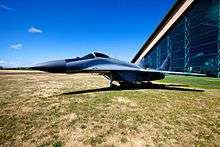
.jpg)
- On display at Goodfellow Air Force Base in San Angelo, Texas.[239]
- On display at the airpark at Naval Air Station Fallon near Fallon, Nevada.[240]
- On display at the Threat Training Facility at Nellis Air Force Base near North Las Vegas, Nevada.[241][242]
- 2960516761 – MiG-29A on display in the Cold War Gallery of the National Museum of the United States Air Force at Wright-Patterson Air Force Base in Dayton, Ohio.[243]
- 2960516766 – On display at the Pima Air and Space Museum in Tucson, Arizona.[244][245]
- On display at the Evergreen Aviation and Space Museum in McMinnville, Oregon.[246]
- 50903012038 – MiG-29UB on display at the National Air and Space Intelligence Center at Wright-Patterson Air Force Base in Dayton, Ohio.[245][247]
Airworthy
- N29UB – MiG-29UB owned by the Flying Heritage Collection in Everett, Washington. The aircraft was obtained from Eastern Europe in early 2009. The aircraft has an FAA approved maintenance program and is flyable.[248]
- N129XX[249] – MiG-29UB owned by Air USA and located at the Quincy Regional Airport in Quincy, Illinois. This aircraft was purchased by Don Kirlin from Kyrgyzstan.[250] It is available for contract training and flight testing.[251]
- Two MiG-29UBs in flying condition were offered for sale from Eastern Europe in spring 2009. These aircraft come from the same source as the flyable aircraft owned by the Historic Flight Foundation.[252]
Specifications (MiG-29)
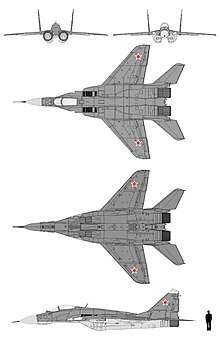
Data from Mikoyan,[253] airforce-technology.com,[254] deagel.com[255], Business World[256]
General characteristics
- Crew: 1
- Length: 17.32 m (56 ft 10 in)
- Wingspan: 11.36 m (37 ft 3 in)
- Height: 4.73 m (15 ft 6 in)
- Wing area: 38 m2 (410 sq ft)
- Empty weight: 11,000 kg (24,251 lb)
- Gross weight: 14,900 kg (32,849 lb)
- Max takeoff weight: 18,000 kg (39,683 lb)
- Fuel capacity: 3,500 kg (7,716 lb) internal
- Powerplant: 2 × Klimov RD-33 afterburning turbofan engines, 81.59 kN (18,340 lbf) with afterburner
Performance
- Maximum speed: 2,400 km/h (1,500 mph, 1,300 kn) at high altitude
- Maximum speed: Mach 2.25
- Range: 1,430 km (890 mi, 770 nmi) with maximum internal fuel[257]
- Ferry range: 2,100 km (1,300 mi, 1,100 nmi) with 1x drop tank
- Service ceiling: 18,000 m (59,000 ft)
- g limits: +9
- Rate of climb: 330 m/s (65,000 ft/min) [258]
- Wing loading: 403 kg/m2 (83 lb/sq ft)
- Thrust/weight: 1.09
Armament
- Guns: 1 × 30 mm Gryazev-Shipunov GSh-30-1 autocannon with 150 rounds
- Hardpoints: 7 × hardpoints (6 × underwing, 1 × fuselage) with a capacity of up to 4,000 kg (8,800 lb) of stores,with provisions to carry combinations of:
Avionics
Notable appearances in media
See also
Related development
Aircraft of comparable role, configuration and era
Related lists
References
Notes
- "The MiG-29 fighters family". Archived 19 June 2015 at the Wayback Machine Russian Aircraft Corporation MiG, 8 December 2014. Retrieved: 19 September 2018.
- Gordon and Davison 2005, p. 61.
- Md. Mamun Murtaza Sheriff. "MiG-29s to be jettisoned". Archived from the original on 4 March 2016. Retrieved 14 November 2014.
- "Многоцелевой истребитель МиГ-29С - Армейский вестник". army-news.ru. Archived from the original on 3 February 2019. Retrieved 2 February 2019.
- Gordon and Davison 2005, p. 9.
- "Scramble". scramble.nl. Archived from the original on 3 February 2019. Retrieved 2 February 2019.
- Jenkins 1998, pp. 9–11.
- Spick 2000, pp. 488–489, 512–513.
- Gordon and Davison 2005, pp. 8–9.
- Correll, John T. "The Reformers." Air Force Magazine Online, February 2008, pp. 7–9. Archived 26 September 2008 at the Wayback Machine
- Lake World Air Power Journal Volume 36 Spring 1999, pp. 110–111.
- Lambert 1993, p. 238.
- Zuyev, A. and Malcolm McConnell. Fulcrum: A Top Gun Pilot's Escape from the Soviet Empire. Clayton, Victoria, Australia: Warner Books, 1993. ISBN 0-446-36498-3.
- Gordon and Davison 2005, pp. 27–29.
- Eden 2004, pp. 310–321.
- "Russian Air Force to Receive 16 New MiG Fighters". RIA Novosti. 15 April 2014. Archived from the original on 18 April 2014. Retrieved 20 April 2014.
- Russia considers funding MiG-29 successor Archived 17 December 2013 at the Wayback Machine - Flightglobal.com, 11 December 2013
- Russia Air Force Handbook, page 180, features. https://books.google.com/books?id=Kt2ZaOilGXIC
- Lake 1987, p. 94.
- "MiG-29 Fulcrum Fighter Bomber". Airforce Technology. Archived from the original on 16 February 2015. Retrieved 14 November 2014.
- "MiG-29 Fulcrum Fighter Bomber". Archived from the original on 7 July 2018. Retrieved 22 August 2018.
- Sotham, John, Solved: The mystery of the MiG-29, Air & Space, September 2014, pp.29–35
- "More MiG Malfunctions." Archived 24 July 2009 at the Wayback Machine Strategy Page, 21 July 2009. Retrieved 14 October 2009.
- Johnson, Reuben F. "The Paris Air Show Twenty Years On." Archived 11 September 2007 at the Wayback Machine Weekly Standard, 18 June 2007. Retrieved 10 March 2009.
- "1993 - 1877 - Flight Archive". Archived from the original on 6 October 2014. Retrieved 14 November 2014.
- "Russia suspends MiG-29 fighter flights over Siberia crash". RIA Novosti. 17 October 2008. Archived from the original on 2 February 2009. Retrieved 28 March 2009.
- "Russian MiG-29 fighter crashes in East Siberia, killing pilot". RIA Novosti. 12 May 2008. Archived from the original on 8 December 2008. Retrieved 28 March 2009.
- "Russian MiG-29 fighter crashes in East Siberia: Pilot dead." Archived 27 July 2009 at the Wayback Machine The Journal of the Turkish Weekly, 5 December 2008. Retrieved 28 March 2009.
- "Some 70% of Russia's MiG-29 fighters unable to fly – experts". RIA Novosti. 2 June 2009. Archived from the original on 9 February 2009. Retrieved 28 March 2009.
- "Russian MiG-29 fighters resume flights after December crash". RIA Novosti. 2 April 2009. Archived from the original on 8 February 2009. Retrieved 28 March 2009.
- "Corrosion issue grounds one-third of Russian air force MiG-29 fleet." Archived 22 March 2009 at the Wayback Machine Flight International, 19 March 2009. Retrieved 14 October 2009.
- Litovkin, Dmitry. "У новых истребителей МиГ-29 выявлена коррозия (MiG-29 pilot did everything to his notice)." Archived 15 March 2009 at the Wayback Machine Izvestia, 23 April 2008. Retrieved 28 March 2009. (English translation)." Archived 21 September 2015 at the Wayback Machine Google. Retrieved 14 October 2009.
- "MiG-29 SMT Fulcrum" Archived 28 March 2013 at the Wayback Machine Retrieved 22 April 2013
- AirForces Monthly, p. 68.
- Isby, David C. "16 Additional MiG-29SMTs for Russia". Air International, June 2014. Vol. 86, No. 6. p. 8.
- "Op Tempo, Sustainment Flaws Hit Russian Air Force". Defense News, 12 July 2015. Retrieved 2 August 2015.
- "Russian MiG Fighter Crashes in Southern Russia, Pilot Lives" New York Times, 3 July 2015. Retrieved 2 August 2015.
- "Военная авиация России переживает всплеск авиапроисшествий". Archived from the original on 8 February 2016. Retrieved 23 January 2016.
- Long, Helen. "Russia ‘shot down Georgia drone’." Archived 22 April 2008 at the Wayback Machine BBC, 21 April 2008. Retrieved 10 March 2009.
- Chivers, C.J."Georgia". Archived from the original on 13 October 2008. Retrieved 5 June 2008.CS1 maint: BOT: original-url status unknown (link) International Herald Tribune, 26 May 2008. Retrieved 10 March 2009.
- "SBU releases more conversations implicating Russia in shooting down Malaysia Airlines flight (VIDEO, TRANSCRIPT)". KyivPost. 19 July 2014. Archived from the original on 2 October 2014. Retrieved 4 October 2014.
- "Spokesman for National Security and Defense Council Information Center: Malaysian Flight MH-17 was outside the range of Ukraine's surface to air defense systems - Ukraine Crisis Media Center - UACRISIS.ORG". uacrisis.org. 18 July 2014. Archived from the original on 28 November 2014. Retrieved 27 April 2015.
- "Russia Rejects 'Absurd' Accusation Over Downed Ukrainian Jet". rferl.org. Radio Free Europe/Radio Liberty. Archived from the original on 17 July 2014. Retrieved 20 July 2014.
- Cenciotti, David (13 September 2017). "Russia Has Deployed Its MiG-29SMT Multirole Combat Aircraft To Syria For The Very First Time". theaviationist.com. Archived from the original on 14 December 2018. Retrieved 2 February 2019.
- "Russia's upgraded MiG-29 fighter jets to test new aircraft armament in Syria". TASS. Archived from the original on 31 October 2018. Retrieved 2 February 2019.
- "Ukrainian Mig-29 Fulcrum evacuated from Crimea, back to operational status". The Aviationist. 4 August 2014. Archived from the original on 7 December 2014. Retrieved 14 November 2014.
- "Ukrainian Mig-29 Fulcrum (in display team livery) performs low pass over pro-Russia separatists". The Aviationist. 16 April 2014. Archived from the original on 2 November 2014. Retrieved 14 November 2014.
- "Militants down Ukrainian MiG-29 in Donetsk region, crew ejects". KyivPost. 7 August 2014. Archived from the original on 27 October 2014. Retrieved 14 November 2014.
- Nick Paton Walsh, Jason Hanna and Catherine E. Shoichet, CNN (7 August 2014). "Ukraine: Rebel leader resigns; military jet shot down". CNN. Archived from the original on 29 November 2014. Retrieved 14 November 2014.CS1 maint: multiple names: authors list (link)
- Harro Ranter. "ASN Aircraft accident 07-AUG-2014 Mikojan-Gurevic MiG-29 02 BLUE". Archived from the original on 1 November 2014. Retrieved 14 November 2014.
- France-Presse, Agence (17 August 2014). "Ukrainian fighter plane shot down by pro-Russia rebels". The Guardian. Archived from the original on 21 March 2017. Retrieved 15 December 2016.
- "Separatists shoot down Ukrainian Mig-29 fighter plane: military". Reuters. 17 August 2014. Archived from the original on 29 November 2014. Retrieved 14 November 2014.
- "Pro-Russia separatists have shot down another Ukrainian Mig-29 Fulcrum". The Aviationist. 17 August 2014. Archived from the original on 25 November 2014. Retrieved 14 November 2014.
- Ukrainian MiG-29 Fighter Jet Being Upgraded with Multi-role Capability, Defenseworld.net, 1 June 2018, retrieved 27 August 2019
- Correll, Diana Stancy (29 May 2020). "B-1Bs complete Bomber Task Force mission with Ukrainian, Turkish aircraft for the first time". Air Force Times. Retrieved 8 June 2020.
- Pike, John. "MiG-29 Baaz." Archived 5 April 2008 at the Wayback Machine globalsecurity.org, 12 March 2009. Retrieved 19 July 2009.
- Kapisthalam, Kaushik. "Warplanes Article Index." Archived 25 March 2008 at the Wayback Machine Strategypage.com, 20 May 2005. Retrieved 16 May 2009.
- "India's MiG-29 fighter jets to be upgraded by Russia." Archived 9 May 2008 at the Wayback Machine India Defence, 8 February 2006. Retrieved 19 July 2009.
- "India has acquired the right to manufacture Saint-Petersburg’s engines." Archived 2 December 2008 at the Wayback Machine Klimov, 24 January 2007. Retrieved 19 July 2009.
- Pandit, Rajat. "India, Russia ink MiG-29 upgrade deal." Archived 2 July 2013 at the Wayback Machine The Times of India, 8 March 2008. Retrieved 19 July 2009.
- "India is worried about its fleet of MiG-29s." Archived 29 July 2009 at the Wayback Machine app.com.pk, 14 March 2009. Retrieved 19 July 2009.
- "India says its MiG-29 safe despite Russian grounding of such aircraft." Archived 11 April 2009 at the Wayback Machine Xinhua News Agency, 14 March 2009. Retrieved 19 July 2009.
- "Antony spills the beans, says Mig-29 structurally flawed." Archived 18 August 2009 at the Wayback Machine IBN Live. Retrieved 14 October 2009.
- Pandit, Rajat. "India, Russia to ink $1.2 bn deal for 29 more MiG-29Ks." Archived 2 February 2014 at the Wayback Machine The Times of India, 18 January 2010. Retrieved 1 August 2010.
- "Indian Navy inducts ‘lethal’ MiG-29K." Archived 21 February 2010 at the Wayback Machine zeenews.com, 19 February 2010. Retrieved 1 August 2010.
- "Indian MiG-29 upgrade". Take-Off. Archived from the original on 4 May 2013. Retrieved 2 September 2012.
- Sabha, Lok. "Upgradation of MIG-29 squadrons." Archived 27 November 2009 at the Wayback Machine pib.nic. Retrieved 1 August 2010.
- "Russia to complete overhaul of 63 Indian fighter jets in 2013". RIA Novosti. 18 October 2009. Archived from the original on 16 May 2010. Retrieved 1 August 2010.
- "Unified' MiG-29 has bright future, says Korotkov." Archived 4 August 2012 at the Wayback Machine Flight International, July 2012. Retrieved 2 September 2012.
- Vladimir Radyuhin (10 December 2012). "Russia delivers 3 upgraded MiG-29s to India". The Hindu. Archived from the original on 17 October 2015. Retrieved 14 November 2014.
- "IAF to immediately buy 21 MiG-29 fighter aircraft to bolster depleting fleet". Archived from the original on 16 February 2019.
- "A Mig 29 fighter jet of Indian Air Force crashes in Punjab". Defence Star. 8 May 2020.
- Gordon and Davison 2005, p. 77.
- "Yugoslav & Serbian MiG-29s." Archived 14 February 2014 at the Wayback Machine Air Combat Information Group, 30 November 2003. Retrieved 14 October 2009.
- Oppenheim, John and Willem-Jan van der Wolf. Global war crimes tribunal collection, Volume 1, Part 1. Nijmegen, the Netherlands: Global Law Association, 1997, p. 404.
- "Case Mig-29". Vreme. 9 November 2000. Archived from the original on 3 October 2016. Retrieved 22 February 2016.
- Lok, Joris Janssen, "How Dutch F-16AMs shot down a Mig-29." janes.com. Retrieved 7 September 2009. Archived 9 July 2006 at the Wayback Machine
- https://www.youtube.com/watch?v=qABnIDOcyS8
- "Niko nije rekao neću, drugi deo Predrag Milutinović pilot". Archived from the original on 7 October 2012. Retrieved 14 November 2014.
- "Mikoyan-Gurevich MiG-29 Fulcrum: Losses & Ejections." Archived 17 October 2007 at the Wayback Machine ejection-history.org.uk, 17 October 2008. Retrieved 7 September 2009.
- Генерал Великович на авиашоу (довоенная фотография). 26 марта ему предстояло сбить F-16 (88-0490 Генерал Великович на авиашоу (довоенная фотография). 26 марта ему предстояло сбить F-16C (88-0490 Archived 3 July 2011 at the Wayback Machine
- Dewitte, Lieven."The US Air Force suspended all F-16 fighter flights at Luke Air Force Base." Archived 11 October 2011 at the Wayback Machine F-16.net, 26 March 1999. Quote: "The US Air Force suspended all F-16 fighter flights at Luke Air Force Base."
- "Archived copy". Archived from the original on 16 April 2015. Retrieved 5 February 2019.CS1 maint: archived copy as title (link)
- "Serbia may receive six MiG-29 fighter jets from Russia". Sputnik (news agency). 11 November 2016. Archived from the original on 13 November 2016. Retrieved 3 March 2019.
- "PM tells why Serbia decided to acquire Russian MiG-29s". B92. Archived from the original on 24 December 2016. Retrieved 24 December 2016.
- Tomkins, Richard (30 January 2017). "Belarus donates MiG-29 fighter aircraft to Serbia". United Press International. Archived from the original on 10 February 2017. Retrieved 25 February 2017.
- "Serbia to Get 8 MiG-29 Fighters, 2 Buk Missile Systems From Belarus". Sputnik (news agency). 28 January 2017. Archived from the original on 4 February 2019. Retrieved 3 March 2019.
- "Serbia Received All Six Russian MiG-29 Fighter Jets as Part of Military Aid". Sputnik (news agency). 4 October 2017. Archived from the original on 14 March 2018. Retrieved 3 March 2019.
- Россия закончила поставку шести истребителей МиГ-29 в Сербию Archived 7 October 2017 at the Wayback Machine RIA Novosti, 4 October 2017.
- "Serbia formally accepted four RAC MiG-29 fighters donated by Belarus during a ceremony at the latter's 558th Aircraft Repair Plant in Baranavichy on 25 February". Flight Global. 26 February 2019. Archived from the original on 6 March 2019. Retrieved 3 March 2019.
- "Serbia receives six MiG-29s donated by Russia". Flightglobal. 25 October 2017. Archived from the original on 25 October 2017. Retrieved 2 November 2017.
- "Serbia hopes to be through with MiG-29 modernization by Putin's visit in November". 29 July 2018. Archived from the original on 6 March 2019. Retrieved 3 March 2019.
- Lake World Air Power Journal Volume 4 Winter 1990/91, p. 86.
- MiG-29s leave Luftwaffe Archived 24 June 2010 at the Wayback Machine – Flug Revue, April 2004
- "MiG-29 Fulcrum (Mikoyan-Gurevich)." Archived 4 January 2016 at the Wayback Machine FAS. Retrieved 1 August 2010.
- Neely, SrA. Dan. "Aviano Vigileer: 'Buzzards' Fly With MiG 29s." AeroWeb. Retrieved 1 August 2010. Archived 4 July 2006 at the Wayback Machine
- "Code One, 1995–07." codeonemagazine.com. Retrieved 30 September 2010. Archived 24 October 2006 at the Wayback Machine
- Lake 1997, p. 70.
- "F/A-18 vs. Mig 29 in "Red October" War Games". Youtube. Discovery Channel. Archived from the original on 2 November 2016. Retrieved 17 February 2019.
- Sotham, John. "The Truth About the Mig 29". Air And Space Smithsonian. Smithsonian Institution. Archived from the original on 17 February 2019. Retrieved 17 February 2019.
- "MiGi za 1 euro w Bydgoszczy." (in Polish) lotnictwo.net. Retrieved 30 September 2010. Archived 28 September 2007 at the Wayback Machine
- "Last of MiG-29s offered by Germany arrive in Poland". AP Worldstream. Associated Press – via HighBeam Research (subscription required) . 4 August 2004. Archived from the original on 23 March 2015. Retrieved 3 October 2014.
- "Bundeswehr." Archived 28 September 2007 at the Wayback Machine mgfa.de.Retrieved 1 August 2010.
- "http://web.archive.org/web/20080816015813/http://www.mindef.gob.pe/informaci…". archive.is. 16 August 2008. Archived from the original on 16 August 2008. Retrieved 2 February 2019. External link in
|title=(help) - "Polish official says pilot of crashed jet saved" . Archived 19 December 2017 at the Wayback Machine ABC News. Retrieved 19 December 2017.
- "Mikojan Gurewicz MiG-29 w Wojsku Polskim" (in Polish). Archived 30 December 2010 at the Wayback Machine gdziewojsko. Retrieved 5 October 2012.
- "Poland Signs $44.5M Deal To Modernize MiG-29s." Defense News, 7 September 2011.
- Agresorzy powrócili z TLP. Archived 6 April 2013 at the Wayback Machine altair (pl.)
- "Polish Air Force MiG-29 Crashes in Minsk Mazowiecki. It's The First Ever Crash Of A Polish Fulcrum" Archived 22 December 2017 at the Wayback Machine The Aviationist, 19 December 2017
- "Polish Fighter Jet Missing, Search Underway" Archived 22 December 2017 at the Wayback Machine Sputnik (news agency), 20 December 2017
- "Wiceszef MON: pilot myśliwca nie katapultował się". TVN24.pl. Retrieved 2 February 2019.
- "Polish MiG-29 jet fighter crashes" Archived 22 December 2017 at the Wayback Machine. Jane's Information Group, 19 December 2017.
- Durman, Natalia (17 July 2018). "Katastrofa MiG-29 w Pasłęku. Wiemy, co mogło doprowadzić do tragedii. Nieoficjalne informacje". wiadomosci.wp.pl (in Polish). Archived from the original on 25 September 2018. Retrieved 24 September 2018.
- "Polish MiG-29 fighter aircraft crashes shortly after takeoff". Defence Blog. 4 March 2019. Archived from the original on 6 March 2019. Retrieved 4 March 2019.
- ""Zobaczyłam, jak spada samolot". Straż: to maszyna wojskowa" TVN 24, 4 March 2019
- https://www.airuniversity.af.edu/Portals/10/ASPJ/journals/Volume-06_Issue-1-4/1992_Vol6_No4.pdf
- Steve Davies. F-15C Eagle Units in Combat, p. 88. Osprey Combat Aircraft 53.
- Archived 1 July 2012 at Archive.today "один самолет Панавиа «Торнадо» английских ВВС [Tornados: BBC, (in Russian). army.lv. Retrieved 23 October 2010.
- "Iraqi air-air victories during the Gulf War 1991." Archived 17 July 2011 at the Wayback Machine safarikovi.org.com, 2004. Retrieved 7 December 2009.
- "ASN Aircraft accident Panavia Tornado GR1 ZA467." Archived 9 October 2011 at the Wayback Machine Flight Safety Foundation via aviation-safety.net, 21 December 2009.
- Lake 2004, pp. 47–48.
- https://nationalinterest.org/blog/buzz/fail-how-russias-mig-29-fulcrum-fighter-isnt-good-it-looks-129167
- "Iran Air Force." Archived 28 February 2012 at the Wayback Machine globalsecurity.org. Retrieved 19 July 2009
- Woods, Kevin M. "Iraqi Perspectives Project Phase II, Um Al-Ma'arik (The Mother of All Battles): Operational and Strategic Insights from an Iraqi Perspective, Volume 1 (Revised May 2008)." Archived 22 July 2011 at the Wayback Machine Defense Technical Information Center via oai.dtic.mil. Retrieved 23 October 2010.
- Kaplan, Fred. "Who disbanded the Iraqi army?" Archived 11 December 2011 at the Wayback Machine Slate, 7 September 2007. Retrieved 9 December 2011.
- "Israeli Air-to-Air Victories since 1974". Archived from the original on 21 February 2009. Retrieved 14 November 2014.
- Cooper, Tom. "Israeli-Syrian Shadow-Boxing." Archived 3 October 2008 at the Wayback Machine ACIG, 30 September 2003. Retrieved 1 August 2010.
- "Ejection history." Archived 17 October 2007 at the Wayback Machine ejection-history.org.uk. Retrieved 1 August 2010.
- "Israel downed 2 Syrian MiGs in 2001." Archived 17 November 2008 at the Wayback Machine WorldTribune.com. Retrieved 1 August 2010.
- "Syrian Mig-29 Fulcrum jets appear in the skies over Damascus during ground attack missions". The Aviationist. 22 October 2013. Archived from the original on 26 February 2015. Retrieved 14 November 2014.
- "Russian Fighter Pilot Shot Down In Sudan." Archived 1 June 2008 at the Wayback Machine strategypage.com, 30 May 2008. Retrieved 1 August 2010.
- Ali, Wasil. "Russia says fighter pilot shot down in Sudan was an ex-military officer." Archived 13 May 2015 at the Wayback Machine sudantribune.com, 30 May 2008. Retrieved 1 August 2010.
- "Russian pilots fly Sudan MIGs in Darfour missions." Archived 1 June 2008 at the Wayback Machine World Tribune, 29 May 2008. Retrieved 1 August 2010.
- Informacje in "Raport - Wojsko Technika Obronność" Nr. 12/2008, p. 62 (in Polish)
- "South Sudan: Nation Guns Down War Plane, Khartoum Denies." Archived 11 November 2013 at the Wayback Machine Allafrica, 5 April 2012.
- "SPLA shoots down Khartoum jet fighter over Heglig: officials." Archived 7 July 2012 at the Wayback Machine Sudan Tribune, 17 April 2012.
- "Transcript." Archived 2 October 2006 at the Wayback Machine Defense Link. Retrieved 30 September 2010.
- "North Korea Air Force Equipment." Archived 10 January 2012 at the Wayback Machine globalsecirity.com. Retrieved 5 October 2012.
- "MiG-29戦闘機(ファルクラム)(北朝鮮)" (in Japanese). Archived 10 February 2012 at the Wayback Machine Atwiki.jp. Retrieved 5 October 2012.
- Schmitt, Eric (4 March 2003). "NORTH KOREA MIG'S INTERCEPT U.S. JET ON SPYING MISSION". The New York Times. Archived from the original on 29 November 2014. Retrieved 14 November 2014.
- Oryx (19 February 2014). "Oryx Blog". Archived from the original on 29 November 2014. Retrieved 14 November 2014.
- "Cuba." Archived 27 December 2007 at the Wayback Machine UMN. Retrieved 1 August 2010.
- Sander Peeters. "Different African Air-to-Air Victories -". acig.org. Archived from the original on 29 November 2014. Retrieved 14 November 2014.
- "II Ethiopian Eritrean War, 1998–2000". acig.org. Archived from the original on 1 February 2010. Retrieved 1 February 2010.
- Cooper, Tom and Jonathan Kyzer (10 February 2008). "Ethiopian Eritrean War, 1998–2000". acig.org. Archived from the original on 10 February 2009. Retrieved 25 July 2011.CS1 maint: uses authors parameter (link)
- "Jane's by IHS Markit". janes.ihs.com. Retrieved 15 August 2017.
- "Argentina Sends Russia Commercial Offer to Buy 15 MiG-29s". Sputnik. 27 January 2017. Archived from the original on 27 January 2017. Retrieved 28 January 2017.
- "Russia Lebanon jets arms supply." Archived 2 February 2017 at the Wayback Machine The Guardian. Retrieved 1 August 2010.
- "Equipping Lebanon's… Government?". Defense Industry Daily. 30 October 2014. Archived from the original on 12 November 2014. Retrieved 14 November 2014.
- "Mikoyan-Gurevich MiG-29A". Archived from the original on 23 August 2018. Retrieved 22 August 2018.
- "Russia helps keep Syria's MiG-29s flying". Archived from the original on 12 June 2014. Retrieved 14 November 2014.
- "Moscow Defense Brief." Archived 20 August 2009 at the Wayback Machine mdb.cast.ru. Retrieved 1 August 2010.
- "Russian MiG-29." Archived 4 March 2008 at the Wayback Machine RIA Novosti. Retrieved 1 August 2010.
- "Mig-29 fighter jet family, Russia" AirForceWorld.com Retrieved 23 August 2013.
- "MiG-29SMT, upgraded MiG-29UB aircraft." Archived 1 March 2011 at the Wayback Machine RAC MiG. Retrieved 1 August 2010.
- "MiG-29SMT/MiG-29UB upgraded". Archived from the original on 27 June 2015. Retrieved 27 May 2015.
- "MiG-29BM Fulcrum" Archived 5 March 2012 at the Wayback Machine "MiG-29BM" Retrieved 18 September 2011
- Furtak, Marek (2016). MiG-29BM - myśliwiec wielozadaniowy Sił Powietrznych Białorusi. in: "Lotnictwo" Nr. 1/2016(177), p. 52-58 (in Polish)
- "CAST comments." Archived 10 May 2007 at the Wayback Machine Centre for Analysis of Strategies and Technologies. Retrieved 2 August 2010.
- "Moscow Defense Brief." Archived 19 September 2009 at the Wayback Machine mdb.cast.ru. Retrieved 1 August 2010.
- Denisov, Anton. "Russia tests upgraded MiG-29 fighter for IAF." Archived 7 February 2011 at the Wayback Machine RIA Novosti. 5 February 2011. Retrieved 9 February 2011.
- Fuerza Aéra del Perú firma contrato para reparar MiG-29." Archived 17 August 2008 at the Wayback Machine Ministry of Defense, 12 August 2008. Retrieved 13 August 2008.
- Wojciechowski, Mariusz. "MiG-29." Archived 15 April 2012 at the Wayback Machine mars.slupsk.pl. Retrieved 28 November 2011
- "La Fuerza Aérea de Perú muestra su capacidad de combate." Archived 30 June 2017 at the Wayback Machine defensa.com, 25 July 2012. Retrieved 25 July 2012.
- MiG-29M / "MiG-29M2." Archived 3 January 2008 at the Wayback Machine RAC MiG. Retrieved 1 August 2010.
- "Latest MiG-29 planes to be flown." Archived 11 December 2007 at the Wayback Machine People's Daily Online. Retrieved 1 August 2010.
- "Russian Aircraft Corporation 'MiG' at Aero India 2005." Archived 8 January 2014 at the Wayback Machine Rac MiG. Retrieved 1 August 2010.
- "ACIG Exclusives: Aero India 2005: Chapter 4." Archived 24 April 2010 at the Wayback Machine acig.org. Retrieved 1 August 2010.
- Seaman, Richard. "MAKS 2005 highlights." Archived 31 May 2007 at the Wayback Machine richard-seaman.com. Retrieved 1 August 2010.
- "MiG-29VFT video from “Smotr” TV-series." Archived 1 June 2007 at the Wayback Machine Aviapedia. Retrieved 1 August 2010.
- "MiG-35/MiG-35D." Archived 18 March 2010 at the Wayback Machine Rac MiG. Retrieved 1 August 2010.
- "MiG Corp. started series production of MiG-29K/KUB for Indian Navy." Archived 14 April 2005 at the Wayback Machine migavia.ru. Retrieved 1 August 2010.
- "MiG-29 K/KUB fighters for India." Archived 28 January 2007 at the Wayback Machine RIA Novosti. Retrieved 1 August 2010.
- "World Military Aircraft Inventory". 2014 Aerospace: Aviation Week and Space Technology, January 2014.
- "World Air Forces 2014" (PDF). Flightglobal Insight. 2014. Archived (PDF) from the original on 10 August 2014. Retrieved 27 August 2014.
- https://www.janes.com/article/91087/algeria-orders-more-russian-fighters
- "World Air Forces 2017" Archived 31 July 2017 at the Wayback Machine. Flight International, 2016.
- Archived 10 July 2015 at the Wayback Machine Defence Minister: Nine of Bulgaria's MiG-29 Fighter Jets Need Repair. Retrieved 9 June 2015.
- Guy Martin. "Chad receiving MiG-29s". defenceweb.co.za. Archived from the original on 21 January 2015. Retrieved 1 April 2015.
- "First of Chad's MIG-29 Arrives In N'Djamena". Open Source IMINT. Archived from the original on 14 October 2014. Retrieved 1 April 2015.
- "Amid Ladakh border standoff, Defence ministry to purchase 21 MiG-29s, 12 Su-30 MKI aircraft". India Today. Retrieved 6 July 2020.
- "India Sanctions Engine Repair Facility for Naval Carrier Aircraft MiG 29K". sputniknews.com. 21 February 2017. Archived from the original on 25 January 2019. Retrieved 12 January 2019.
- Taghvaee, Babak (June 2012). "Guardians of Tehran: Iranian Fulcrums". Combat Aircraft Monthly: 70–73.
- "Archived copy". Archived from the original on 23 January 2019. Retrieved 3 March 2019.CS1 maint: archived copy as title (link)
- "Only four out of RMAF's 28 Russian fighter jets can fly". 31 July 2018. Archived from the original on 25 August 2018. Retrieved 4 December 2018.
- https://www.medee.mn/single/141508
- "World Military Aircraft Inventory". 2015 Aerospace: Aviation Week and Space Technology, January 2015.
- Flightglobal - World Air Forces 2015 Archived 19 December 2014 at the Wayback Machine (PDF), Flightglobal.com, 2015.
- Peruvian MiG upgrades Archived 7 February 2013 at the Wayback Machine. Flightglobal.com, February 4, 2013
- Russia, Peru to Sign MiG-29 Jet Upgrade Deal Archived 17 August 2013 at the Wayback Machine. Defense-Aerospace.com, May 20, 2013
- "World Air Forces 2018". Flightglobal Insight. 2018. Archived from the original on 2 December 2017. Retrieved 1 December 2017.
- "World Air Forces 2017". Flightglobal Insight. 2017. Archived from the original on 19 January 2016. Retrieved 2 November 2017.
- "Russian Navy to buy 24 MiG-29K carrier-based fighters". Rian.ru. 9 October 2009. Archived from the original on 6 June 2011. Retrieved 5 July 2011.
- Radio Free Europe/Radio Liberty. "Russia Formally Hands Over Mig-29 Fighter Jets To Serbia". Retrieved 2 February 2019 – via YouTube.
- "Российские МиГ-29 для Сербии". bmpd.livejournal.com. 4 October 2017. Retrieved 2 November 2017.
- "Serbia receives four MiG-29 fighter jets from Belarus - defense minister". TASS. 22 April 2018. Archived from the original on 11 January 2019. Retrieved 11 January 2019.
- "ILA 2008: Slovakian MiG upgrade debuts at Berlin". Flight Global. 29 May 2008. Archived from the original on 17 November 2017. Retrieved 16 November 2017.
- "Russia's MiG hands 12 upgraded fighters over to Slovakia". Sputnik (news agency). 29 February 2008. Archived from the original on 15 July 2018. Retrieved 16 November 2017.
- "Letecká technika Taktického krídla Sliač". lzsliac.mil.sk. Archived from the original on 15 July 2018. Retrieved 16 November 2017.
- Slovakia: Why is a Nato state using Soviet-designed jets?, BBC News, 6 June 2018, retrieved 27 August 2019
- "WorldAirForces2017-Landscape.pdf". Archived from the original on 31 July 2017. Retrieved 11 June 2017.
- http://www.airrecognition.com/index.php/news/defense-aviation-news/2020/may/6284-russia-has-delivered-second-batch-of-advanced-mig-29-fighter-aircraft-to-syria.html
- Ponomarenko, Illia (15 March 2019). "Ukraine's Air Force rebuilds amidst war". Kyiv Post. Kyiv, Ukraine. Retrieved 3 September 2019.
- Air USA. "Our Aircraft". Archived from the original on 15 November 2014. Retrieved 14 November 2014.
- "World Military Aircraft Inventory". 2011 Aerospace: Aviation Week and Space Technology, January 2011.
- "Vége, ennyi volt… (A MiG-29 és üzemeltetőik emlékére)." Archived 14 January 2011 at the Wayback Machine JETfly Magazin. Retrieved 5 October 2012.
- "MIG-29-est vegyenek!" nol.hu. Népszabadság, 12 August 2011.
- Dunai, Peter (31 October 2017). "Hungary auctions off MiG-29s". IHS Jane's 360. Archived from the original on 1 November 2017. Retrieved 1 November 2017.
- "US buys Su-27 fighters from Ukraine for ‘aggressor’ training." defencetalk.com, 13 May 2009. Retrieved 1 August 2010.
- "IAF Magazine: The “Sting” has landed" Archived 1 February 2014 at the Wayback Machine iaf.co.il
- DefenseLink News Transcript, DoD News Briefing: Cooperative Threat Reduction Initiative Archived 2 October 2006 at the Wayback Machine
- "Arms Control Association: Arms Control Today: U.S. Buys Moldovan Aircraft to Prevent Acquisition by Iran". Archived from the original on 10 January 2008. Retrieved 14 November 2014.
- "Romanian International Air Show." Archived 23 June 2009 at the Wayback Machine targeta.co.uk. Retrieved 1 August 2010.
- Yugoslav & Serbian MiG-29s Archived 14 February 2014 at the Wayback Machine, acig.org. Retrieved 28 March 2013.
- Novinky.cz: Letecké muzeum Kbely láká na unikát. Slavnou sovětskou stíhačku MiG-29 Archived 27 May 2016 at the Wayback Machine Retrieved 26 May 2016.
- "Laage without MiG-29!". Fabulous Fulcrums. August 2006. Archived from the original on 8 October 2016. Retrieved 24 August 2016.
- "MiG-29 Spotter´s Collection". Fabulous Fulcrums. Archived from the original on 15 August 2016. Retrieved 24 August 2016.
- "Reptár - Szolnoki repülőmúzeum" (in Hungarian). Archived from the original on 30 March 2019. Retrieved 30 March 2019.
- "Warbirds : Preserved Vintage Military and Civilian Aircraft". Warbirds of India. WarbirdsofIndia.com. Archived from the original on 5 October 2016. Retrieved 24 August 2016.
- "MiG-29UB". Riga Airmuseum. AGK.lv. Archived from the original on 28 August 2016. Retrieved 24 August 2016.
- "Airframe Dossier - Mikoyan Gurevich MiG-29UB, s/n 52 Blue, c/n 952". Aerial Visuals. AerialVisuals.ca. Archived from the original on 8 October 2016. Retrieved 24 August 2016.
- "Samolot myśliwski MIG 29". Muzeum Wojska Polskiego. Archived from the original on 27 August 2016. Retrieved 24 August 2016.
- "Mikoyan-Gurevich MiG-29GT (UB) (NATO: Fulcrum-B)". Polish Aviation Museum. NeoServer. Archived from the original on 12 July 2016. Retrieved 23 August 2016.
- "Airframe Dossier - Mikoyan Gurevich MiG-29AS, s/n 67 {2} FARo, c/n 2960532367/4305". Aerial Visuals. AerialVisuals.ca. Archived from the original on 8 October 2016. Retrieved 24 August 2016.
- "Airframe Dossier - Mikoyan Gurevich MiG-29 Fulcrum-A (NATO), s/n 01 blue {1} VVS, c/n 9-01". Aerial Visuals. AerialVisuals.ca. Archived from the original on 14 October 2016. Retrieved 23 August 2016.
- Belyakov, R. A. (1994). MiG: Fifty Years of Secret Aircraft Design. Annapolis, Maryland: Naval Institute Press. p. 421. ISBN 978-1-55750-566-8.
- "Airframe Dossier - Mikoyan Gurevich MiG-29 Fulcrum-A (NATO), s/n 03 blue VVS, c/n 0390502020". Aerial Visuals. AerialVisuals.ca. Archived from the original on 14 October 2016. Retrieved 23 August 2016.
- "Airframe Dossier - Mikoyan Gurevich MiG-29B-12, s/n 70 Blue VVS, c/n 2960710039". Aerial Visuals. AerialVisuals.ca. Archived from the original on 14 October 2016. Retrieved 23 August 2016.
- "Airframe Dossier - Mikoyan Gurevich MiG-29B-12, s/n 51 Blue Russian AF, c/n 2960718121". Aerial Visuals. AerialVisuals.ca. Archived from the original on 14 October 2016. Retrieved 23 August 2016.
- "Airframe Dossier - Mikoyan Gurevich MiG-29, s/n 18 blue VVS, c/n 9-18". Aerial Visuals. AerialVisuals.ca. Archived from the original on 14 October 2016. Retrieved 23 August 2016.
- "Airframe Dossier - Mikoyan Gurevich MiG-29 Fulcrum-A (NATO), s/n 26 blue, c/n 05560". Aerial Visuals. AerialVisuals.ca. Archived from the original on 8 October 2016. Retrieved 1 December 2016.
- "Airframe Dossier - Mikoyan Gurevich MiG-29 Fulcrum-A (NATO), s/n 04 blue VVS, c/n 904". Aerial Visuals. AerialVisuals.ca. Archived from the original on 8 October 2016. Retrieved 23 August 2016.
- Wilson, Alan (15 August 2012). "Mikoyan MiG-29 Fulcrum '02 red'". Flickr. Archived from the original on 20 October 2016. Retrieved 23 August 2016.
- https://kosice.korzar.sme.sk/c/6799514/do-kosic-vcera-priviezli-stihacku-mig-29.html
- https://www.valka.cz/topic/view/51617
- https://www.valka.cz/topic/view/51607
- https://www.valka.cz/topic/view/51605
- "MIG-29 receives a new home". Goodfellow Air Force Base. 22 May 2013. Archived from the original on 11 September 2016. Retrieved 23 August 2016.
- "NAS Fallon". AeroResource. 3 March 2016. Archived from the original on 11 April 2016. Retrieved 2 February 2019.
- "Airframe Dossier - Mikoyan Gurevich MiG-29S, s/n 06 white MoAF, c/n 2960717473". Aerial Visuals. AerialVisuals.ca. Archived from the original on 8 October 2016. Retrieved 23 August 2016.
- Seaman, Richard. "Nellis AFB Threat Training Facility Aircraft". The Flying Kiwi. Archived from the original on 30 June 2007. Retrieved 23 August 2016.
- "Mikoyan-Gurevich MiG-29A". National Museum of the US Air Force. 29 May 2015. Archived from the original on 22 November 2016. Retrieved 23 August 2016.
- "FULCRUM-A". Pima Air & Space Museum. PimaAir.org. Archived from the original on 10 August 2016. Retrieved 23 August 2016.
- "AIRCRAFT ON LOAN (by Location)" (PDF). National Museum of the US Air Force. Archived (PDF) from the original on 22 November 2016. Retrieved 8 November 2016.
- "Military Aircraft". Evergreen Museum Campus. Evergreen Museum. Archived from the original on 15 August 2016. Retrieved 23 August 2016.
- "Airframe Dossier - Mikoyan Gurevich MiG-29UB-12, s/n 61 yellow MoAF, c/n N50903012038". Aerial Visuals. AerialVisuals.ca. Archived from the original on 8 October 2016. Retrieved 23 August 2016.
- "Mikoyan MiG-29UB Fulcrum". Flying Heritage Collection. Archived from the original on 12 May 2014. Retrieved 28 May 2014.
- "FAA REGISTRY [N129XX]". Federal Aviation Administration. U.S. Department of Transportation. Archived from the original on 8 October 2016. Retrieved 24 August 2016.
- Hoffman, Carl (October 2005). "Building Your Own Air Force, One Mig at a Time". Wired Magazine (13.10). Archived from the original on 31 July 2013. Retrieved 10 March 2017.
- "Aircraft". Air USA. Archived from the original on 15 November 2014. Retrieved 30 November 2014.
- Day 2009, pp. 12–13.
- "MiG-29/MiG-29UB/MiG-29SE." Archived 18 May 2016 at the Wayback Machine RAC MiG. Retrieved 21 June 2016.
- "MiG-29 Fulcrum Fighter Bomber". Archived from the original on 16 February 2015. Retrieved 1 July 2011.
- "Mig-29". Archived from the original on 27 June 2017. Retrieved 27 June 2017.
- "Air Force to get 33 new fighter jets, 248 indigenous Astra missiles". BusinessWorld. Retrieved 2 July 2020.
- "MiG-29." Jane's Aircraft Upgrades , Jane's Information Group, subscription article dated 10 July 2009.
- "Datafiles: Mikojan MiG-29". Archived from the original on 20 June 2008. Retrieved 31 May 2008.CS1 maint: BOT: original-url status unknown (link) Flug Revue, 1 September 1998. Retrieved 13 August 2010.
- https://www.janes.com/images/assets/018/45018/Sky_searchers.pdf
- http://www.kagero.pl/index.php?option=com_content&view=article&id=368:mig-29&catid=95&Itemid=688
Bibliography
- Day, Jerry. "Hot Hot Hot!" Air Classics, Volume 45, Issue 4, April 2009.
- Eden, Paul, ed. "Mikoyan MiG-29 Fulcrum". Encyclopedia of Modern Military Aircraft. London: Amber Books, 2004. ISBN 1-904687-84-9.
- Gordon, Yefim and Peter Davison. Mikoyan Gurevich MiG-29 Fulcrum. North Branch, Minnesota: Specialty Press, 2005. ISBN 978-1-58007-085-0.
- Jenkins, Dennis R. McDonnell Douglas F-15 Eagle, Supreme Heavy-Weight Fighter. Arlington, Texas: Aerofax, 1998. ISBN 1-85780-081-8.
- Lake, Jon. "Mikoyan MiG-29 'Fulcrum'". World Air power Journal. Volume 4, Winter 1990/91. London: Aerospace Publishing. pp. 44–91. ISBN 1-874023-06-9. ISSN 0959-7050.
- Lake, Jon. Jane's How to Fly and Fight in the Mikoyan MiG-29. New York: HarperCollins, 1997. ISBN 0-00-472144-6.
- Lake, Jon. "Variant Briefing: Mikoyan MiG-29". World Air Power Journal Volume 36, Spring 1999. London: Aerospace Publishing. pp. 108–135. ISBN 978-1-86184-027-1.
- Lambert, Mark. Jane's All The World's Aircraft 1993–94. Coulsdon, UK: Jane's Data Division, 1993. ISBN 0-7106-1066-1.
- North, David M. MiG-29 Pilot Report, part 1 Part 2
- Spick, Mike, ed. "MiG-29 'Fulcrum'". "The Flanker". Great Book of Modern Warplanes. St. Paul, Minnesota: MBI Publishing, 2000. ISBN 0-7603-0893-4.
External links
| Wikimedia Commons has media related to Mikoyan MiG-29. |
- MiG-29/-29UB/-29SE, MiG-29SD, MiG-29SMT, upgraded MiG-29UB, and MiG-29K/KUB on the MiG Corporation website
- MiG-29 Flight manual
- German Luftwaffe's former MiG-29 Staffel 1./JG 73 "Steinhoff" in Laage
- MiG-29 page on globalSecurity.org
- MiG-29 page on milavia.net
- Cuban MiG-29
- Intensive Finish study on positive and negative features of the MiG-29 fighter
- How To Win In A Dogfight: Stories From A Pilot Who Flew F-16s And MiGs
- The Truth About the MiG-29